Paul van Yperen's Blog, page 392
February 4, 2015
Michèle Alfa
Michèle Alfa (1911-1987) was one of the most beloved stars of the French cinema during the Second World War.
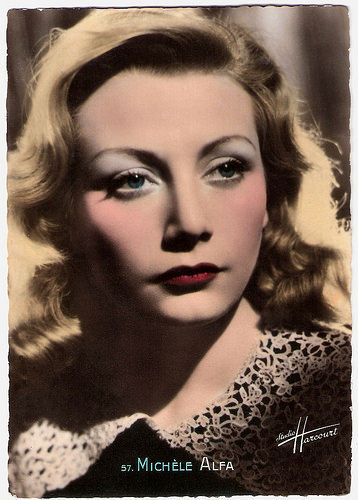
French postcard by Greff Editeur, Paris, no. 57. Photo: Studio Harcourt.
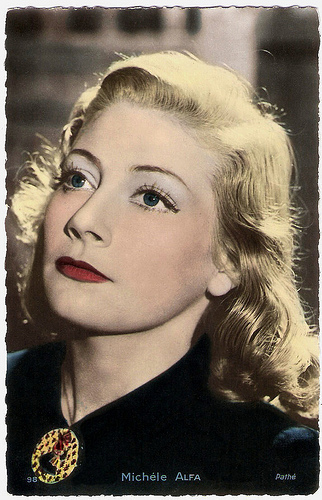
French postcard by Editions E.C., Paris, no. 98. Photo: Pathé.
A future on stage
Michèle Alfa was born as Josephine Blanche Alfreda Bassignot in Gujan Mestras, France, in 1911. Her stage name Alfa is short for one of her first names, Alfreda.
At the age of 15, she became smitten with the theatre when she attended the play Felix by Henri Bernstein at the Théâtre du Gymnase (Theatre Gymnasium). The play’s star was the popular Gaby Morlay .
When Alfa was refused permission to enter the Conservatoire, she tried to commit suicide. She was sure her future had to be on stage. Wisely, she applied for lessons from Raymond Rouleau.
At 20, she began with a stage tour of France. She participated in good plays including L'Héritière, a French adaptation of the play The Heiress by Louis Ducreux, Mademoiselle de Panama (Miss Panama) by Marcel Achard , La Machine à écrire (The Typewriter) by Jean Cocteau, and Huis Clos (Locked) by Jean Paul Sartre.
From 1932 on, she also appeared in films. Her debut, La Belle Aventure/The beautiful adventure (Reinhold Schünzel, Roger Le Bon, 1932) was the alternate-language version of the German comedy Das Schöne Abenteuer (Reinhold Schünzel, 1932), both starring Käthe von Nagy .
Her first leading lady part was in the dramatic comedy Lumières de Paris/Lights of Paris (Richard Pottier, 1938) opposite singer Tino Rossi . She also played the leading lady opposite Charles Boyer in Le Corsaire/The Corsican (Marc Allégret, 1939), but this film was never finished because of the Second World War.
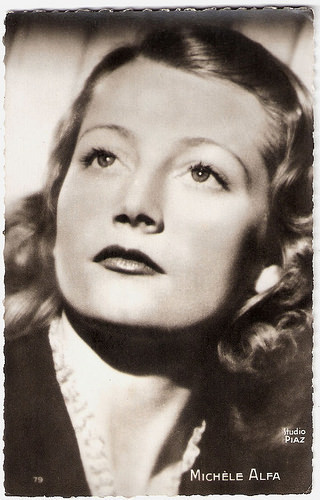
French postcard by Editions P.I., Paris, no. 79. Photo: Studio Piaz.
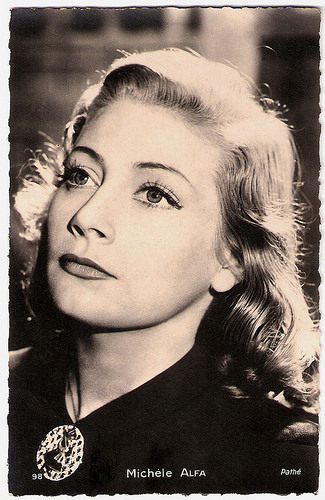
French postcard by Ed. Chantal, Rueil, no. 98. Photo: Pathé.
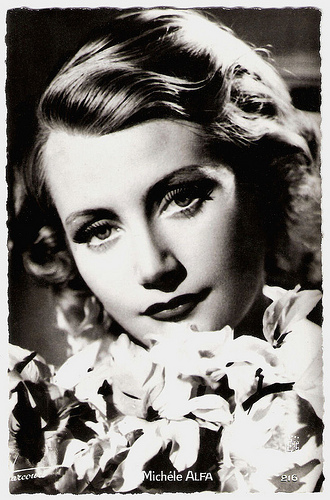
French postcard by EPC (Editions et Publications Cinematographiques), no. 216. Photo: Studio Harcourt.
Mistress of Goebbels' Nephew
Under the Occupation of France by the Nazis, Michèle Alfa became the mistress of Bernhardt Rademecker. This nephew of Josef Goebbels was appointed at the Propagandastaffel as head of the Paris theatres. Alfa knew him from before the war, when he had been a jazz trumpeter in Pigalle. During the war years, he would protect Jews like the actor Henry Murray, father of Anouk Aimée .
In the cinema, Alfa starred in 13 films, both comedies and dramas. These included L'homme qui vendit son âme/The Man Who Sold His Soul to the Devil (Jean-Paul Paulin, 1943) with André Luguet , and L'ange de la nuit/Angel of the night (André Berthomieu, 1943), in which she offers herself for a soldier ( Jean-Louis Barrault ) who returns blind from the war.
Her strange, sometimes sad face, her blonde hair and her talent, made her a darling of the public. Very popular was the two-parter Le comte de Monte Cristo/The Count of Monte Cristo (Robert Vernay, 1943), based on the famous novel by Alexandre Dumas. Alfa played Mercedes the fiancée of Edmond Dantes ( Pierre Richard-Willm ).
James Travers at French Films Site : “The Monte Cristo story has been adapted so many times for cinema (28 versions between 1907 à 1971) that some of the best adaptations have been almost overlooked. Vernay's film certainly deserves a higher profile than it has enjoyed to date, even if it lacks the star names which make some of the other versions more saleable.”
After the war Michèle Alfa starred in only four more films, including the drama Sombre dimanche/Gloomy Sunday (Jacqueline Audry, 1948). Her final film was the ensemble comedy Agence matrimonial/Matrimonial Agency (Jean-Paul Le Chanois, 1952). She continued to appear on stage till the mid-1960s.
From 1942 to 1946, Alfa was married to actor Paul Meurisse . In 1959, she married her second husband, corporate director Philippe Plouffe. Michèle Alfa died in 1987 in Le Vésinet, a suburb of Paris. She was 76.
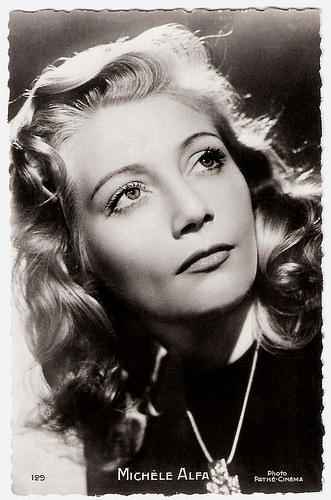
French postcard by Editions P.I., Paris, no. 129. Photo: Pathé-Cinema.
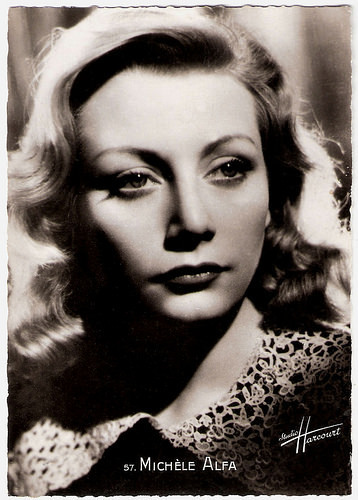
French postcard by S.E.R.P., Paris, no. 57. Photo: Studio Harcourt.
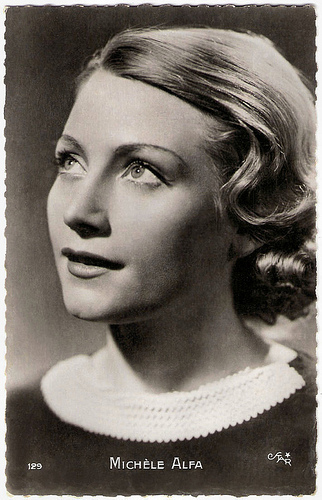
French postcard by Editions P.I., Paris, no. 129. Photo: Star.
Sources: Caroline Hanotte (CinéArtistes – French), Wikipedia (French) and .

French postcard by Greff Editeur, Paris, no. 57. Photo: Studio Harcourt.

French postcard by Editions E.C., Paris, no. 98. Photo: Pathé.
A future on stage
Michèle Alfa was born as Josephine Blanche Alfreda Bassignot in Gujan Mestras, France, in 1911. Her stage name Alfa is short for one of her first names, Alfreda.
At the age of 15, she became smitten with the theatre when she attended the play Felix by Henri Bernstein at the Théâtre du Gymnase (Theatre Gymnasium). The play’s star was the popular Gaby Morlay .
When Alfa was refused permission to enter the Conservatoire, she tried to commit suicide. She was sure her future had to be on stage. Wisely, she applied for lessons from Raymond Rouleau.
At 20, she began with a stage tour of France. She participated in good plays including L'Héritière, a French adaptation of the play The Heiress by Louis Ducreux, Mademoiselle de Panama (Miss Panama) by Marcel Achard , La Machine à écrire (The Typewriter) by Jean Cocteau, and Huis Clos (Locked) by Jean Paul Sartre.
From 1932 on, she also appeared in films. Her debut, La Belle Aventure/The beautiful adventure (Reinhold Schünzel, Roger Le Bon, 1932) was the alternate-language version of the German comedy Das Schöne Abenteuer (Reinhold Schünzel, 1932), both starring Käthe von Nagy .
Her first leading lady part was in the dramatic comedy Lumières de Paris/Lights of Paris (Richard Pottier, 1938) opposite singer Tino Rossi . She also played the leading lady opposite Charles Boyer in Le Corsaire/The Corsican (Marc Allégret, 1939), but this film was never finished because of the Second World War.

French postcard by Editions P.I., Paris, no. 79. Photo: Studio Piaz.

French postcard by Ed. Chantal, Rueil, no. 98. Photo: Pathé.

French postcard by EPC (Editions et Publications Cinematographiques), no. 216. Photo: Studio Harcourt.
Mistress of Goebbels' Nephew
Under the Occupation of France by the Nazis, Michèle Alfa became the mistress of Bernhardt Rademecker. This nephew of Josef Goebbels was appointed at the Propagandastaffel as head of the Paris theatres. Alfa knew him from before the war, when he had been a jazz trumpeter in Pigalle. During the war years, he would protect Jews like the actor Henry Murray, father of Anouk Aimée .
In the cinema, Alfa starred in 13 films, both comedies and dramas. These included L'homme qui vendit son âme/The Man Who Sold His Soul to the Devil (Jean-Paul Paulin, 1943) with André Luguet , and L'ange de la nuit/Angel of the night (André Berthomieu, 1943), in which she offers herself for a soldier ( Jean-Louis Barrault ) who returns blind from the war.
Her strange, sometimes sad face, her blonde hair and her talent, made her a darling of the public. Very popular was the two-parter Le comte de Monte Cristo/The Count of Monte Cristo (Robert Vernay, 1943), based on the famous novel by Alexandre Dumas. Alfa played Mercedes the fiancée of Edmond Dantes ( Pierre Richard-Willm ).
James Travers at French Films Site : “The Monte Cristo story has been adapted so many times for cinema (28 versions between 1907 à 1971) that some of the best adaptations have been almost overlooked. Vernay's film certainly deserves a higher profile than it has enjoyed to date, even if it lacks the star names which make some of the other versions more saleable.”
After the war Michèle Alfa starred in only four more films, including the drama Sombre dimanche/Gloomy Sunday (Jacqueline Audry, 1948). Her final film was the ensemble comedy Agence matrimonial/Matrimonial Agency (Jean-Paul Le Chanois, 1952). She continued to appear on stage till the mid-1960s.
From 1942 to 1946, Alfa was married to actor Paul Meurisse . In 1959, she married her second husband, corporate director Philippe Plouffe. Michèle Alfa died in 1987 in Le Vésinet, a suburb of Paris. She was 76.

French postcard by Editions P.I., Paris, no. 129. Photo: Pathé-Cinema.

French postcard by S.E.R.P., Paris, no. 57. Photo: Studio Harcourt.

French postcard by Editions P.I., Paris, no. 129. Photo: Star.
Sources: Caroline Hanotte (CinéArtistes – French), Wikipedia (French) and .
Published on February 04, 2015 22:00
February 3, 2015
Klaus Collignon
Germany was a frontrunner of film star postcards in colour. During the 1950s and 1960s, Klaus Collignon was one of the photographers whose colour studio portraits were often used for postcards by such German publishers as UFA and WS-Druck. He made highly polished portraits of the Italian sex goddesses Sophia Loren and Gina Lollobrigida, but also wonderful pictures of the innocent-looking German stars of the Heimatfilms like Sonja Ziemann.
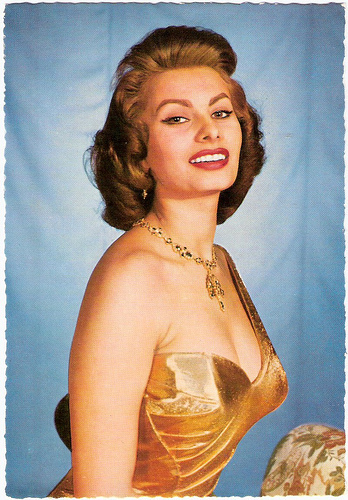
Sophia Loren . German Postcard by WS-Druck, Wanne-Eickel, no. F 13. Photo: Klaus Collignon.

Gina Lollobrigida . French postcard by Editions P.I., Paris, offered by Les carbones Korès 'Carboplane', no. 97. Photo: Klaus Collignon.
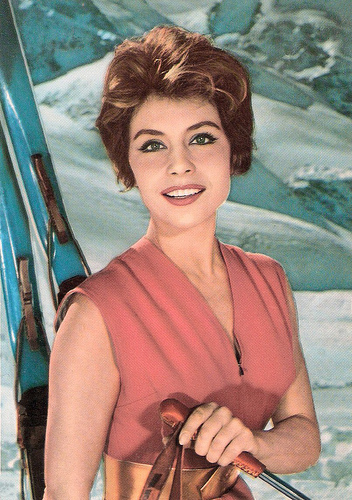
Sonja Ziemann . French postcard by Edition P.I., Paris, no. CK-238. P.I. was the French licency holder for UFA, Berlin-Tempelhof. Photo: Klaus Collignon / UFA.
La Loren
Klaus Collignon is most known for his highly polished studio portraits, which were used in international magazines like the German Neue Illustrierte and the French Paris Match, and for many postcards.
They are still often used today. An example is the recently published biography of Sophia Loren , Yesterday, Today And Tomorrow - My Life (2014), which contains a photo of her by the German photographer.
But Collignon was also a still photographer who worked on film sets, e.g. on the set of the popular German Western Der Schatz im Silbersee/The Treasure of the Silver Lake (Harald Reinl, 1962) and Sophia Loren 's film Madame sans gêne (Christian Jacque, 1961)
On the site Flash Projects there is another wonderful picture of La Loren, at which Collignon captures her in a quiet moment on a set. Unaware of the camera, Loren absent-mindedly plays with her shoe under the table.
The style of this sweet image reveals the developing appetite in the 1960s for portraits of stars that were unposed and more realistic, depicting not only the subject’s public persona but also revealing their character outside of the public eye.
Klaus Collignon obviously was a master of both styles.
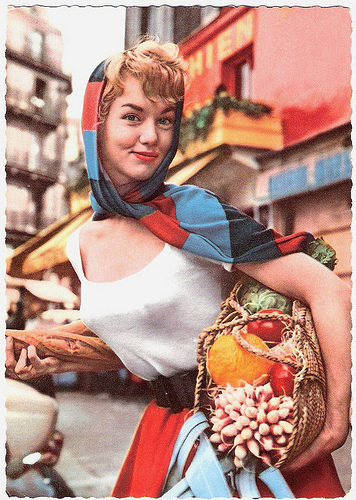
Mylène Demongeot . German postcard by Universum-Film Aktiengesellschaft (UFA), Berlin-Tempelhof, no. CK 150. Retail price: 30 Pfg. Photo: Klaus Collignon / UFA.
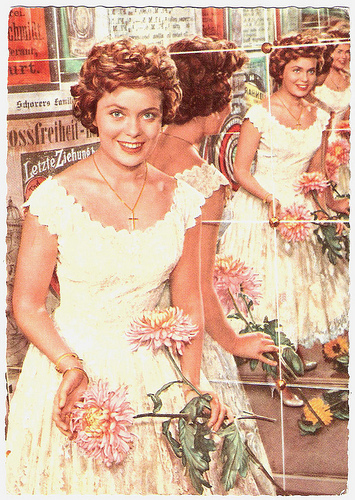
Ulla Jacobsson . German postcard by Universum-film Aktiengesellschaft (UFA), Berlin-Templehof, nr. CK-247. Retail price: 30 Pfg. Photo: Klaus Collignon.
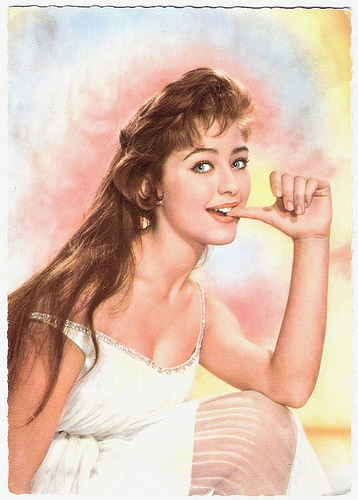
Christine Kaufmann . German postcard by Universum-Film Aktiengesellschaft (UFA), Berlin-Tempelhof, no. CK 302. Photo: Klaus Collignon / UFA.
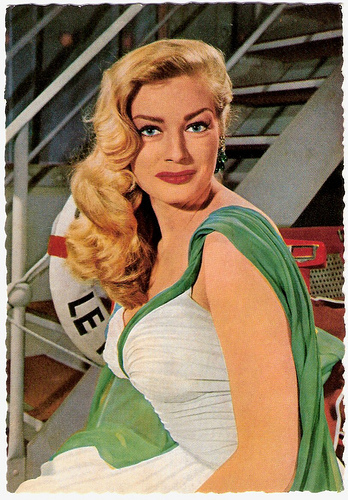
Anita Ekberg . German postcard by WS-Druck, Wanne-Eickel. Photo: Klaus Collignon.
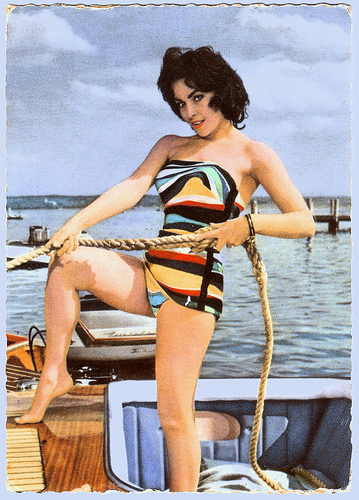
Mara Lane . German postcard by UFA, no. CK-200. Photo: Klaus Collignon / UFA.
Leni Riefenstahl's sister-in-law
But who was Klaus Collignon? It is not easy to find online information about him. But his pictures on the net lead to bits of information that give an indication of his life and career.
During the Second World War, Klaus Collignon was a war correspondent and cameraman. At the historical photo community V like Vintage , there is a 1942 photo of Collignon filming military action in the harbour of La Spezia in Italy.
On the same site, there is a photo he made of three young women on a sailing boat. One of them was Ilse Riefenstahl-Rehtmeyer, who had just divorced Leni Riefenstahl ’s brother Heinz.
Klaus and Ilse married in 1943. After the war, they divorced but Ilse always kept his name.
In 2003, Ilse Collignon published the memoir Liebe Leni about her first husband Heinz Riefenstahl and his sister Leni, who she described as a ruthless careerist unscrupulously using her close Nazi contacts to enforce her will.
Klaus married his second wife, Rosemarie, and in 1951, their son Stefan Colin Collignon was born in Munich. Stefan is now professor of political economy at St Anna School of Advanced Studies, Pisa and president of the Scientific Committee of Centro Europa Ricerche (CER), Rome.
During the 1960s, Collignon once worked again as a cinematographer. He did the camera work for the short black and white film Vor der Kamera/Before the camera (Eberhard Hauff, 1964). According to both IMDb and Filmportal.de , it was his only film credit.
If you have more information about Klaus Collignon, please let us know.
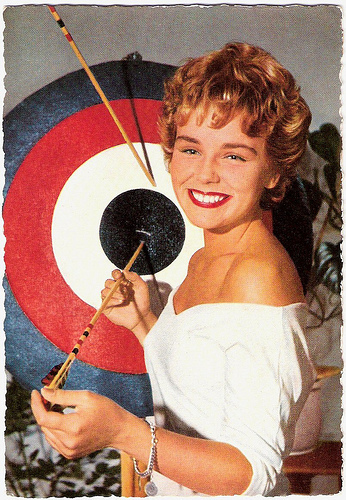
Susanne Cramer . German postcard by WS-Druck, Wanne-Eickel, no. F 77. Photo: Collignon.
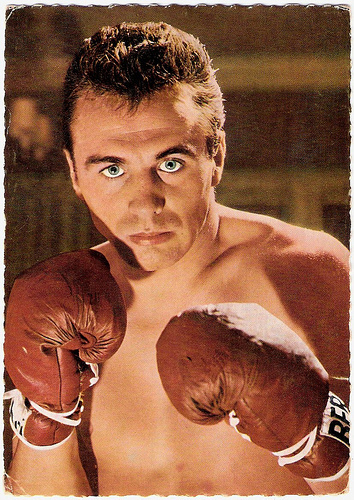
Gustav 'Bubi' Scholz . German postcard by UFA (Universum-Film Aktiengesellschaft), Berlin-Tempelhof, no. CK 342. Retail price: 30 Pfg. Photo: Klaus Collignon / UFA.
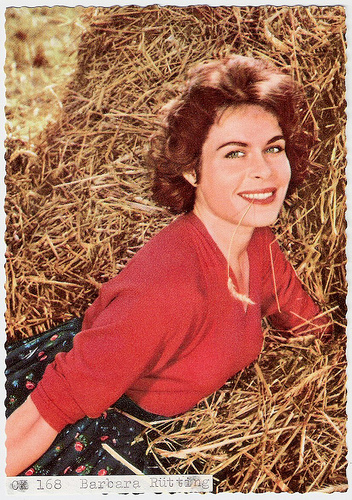
Barbara Rütting . German postcard by UFA (Universum-Film Aktiengesellschaft), Berlin-Tempelhof, no. CK-168. Retail price: 30 Pfg. Photo: Klaus Collignon / UFA.

Liselotte Pulver . German postcard by WS-Druck, Wanne-Eickel, no. F 42. Photo: Collignon.
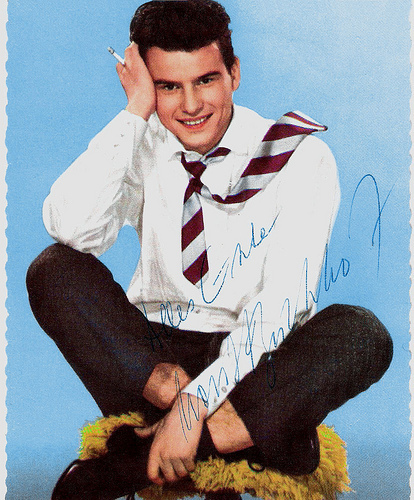
Horst Buchholz . German postcard by UFA (Universal-Film Aktiengesellschaft), Berlin-Tempelhof, no. CK-145. Photo: Klaus Collignon / UFA. Top and bottom sides of the postcard were cut off.
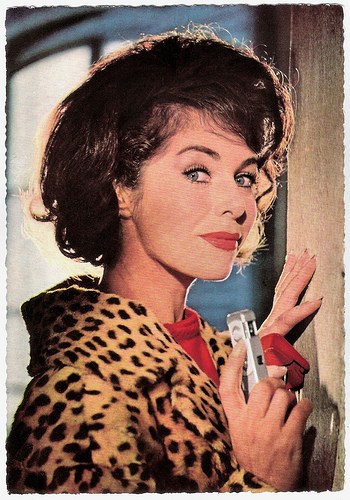
Marianne Koch . German postcard by Krüger, no. 902/187. Photo: Klaus Collignon.
Check out our other posts on film star photographers. See the links at right under the caption 'The Photographers'.
Sources: Ilse Collignon (Liebe Leni), V like Vintage, Flash projects, The International Who's Who, Filmportal.de, and .

Sophia Loren . German Postcard by WS-Druck, Wanne-Eickel, no. F 13. Photo: Klaus Collignon.

Gina Lollobrigida . French postcard by Editions P.I., Paris, offered by Les carbones Korès 'Carboplane', no. 97. Photo: Klaus Collignon.

Sonja Ziemann . French postcard by Edition P.I., Paris, no. CK-238. P.I. was the French licency holder for UFA, Berlin-Tempelhof. Photo: Klaus Collignon / UFA.
La Loren
Klaus Collignon is most known for his highly polished studio portraits, which were used in international magazines like the German Neue Illustrierte and the French Paris Match, and for many postcards.
They are still often used today. An example is the recently published biography of Sophia Loren , Yesterday, Today And Tomorrow - My Life (2014), which contains a photo of her by the German photographer.
But Collignon was also a still photographer who worked on film sets, e.g. on the set of the popular German Western Der Schatz im Silbersee/The Treasure of the Silver Lake (Harald Reinl, 1962) and Sophia Loren 's film Madame sans gêne (Christian Jacque, 1961)
On the site Flash Projects there is another wonderful picture of La Loren, at which Collignon captures her in a quiet moment on a set. Unaware of the camera, Loren absent-mindedly plays with her shoe under the table.
The style of this sweet image reveals the developing appetite in the 1960s for portraits of stars that were unposed and more realistic, depicting not only the subject’s public persona but also revealing their character outside of the public eye.
Klaus Collignon obviously was a master of both styles.

Mylène Demongeot . German postcard by Universum-Film Aktiengesellschaft (UFA), Berlin-Tempelhof, no. CK 150. Retail price: 30 Pfg. Photo: Klaus Collignon / UFA.

Ulla Jacobsson . German postcard by Universum-film Aktiengesellschaft (UFA), Berlin-Templehof, nr. CK-247. Retail price: 30 Pfg. Photo: Klaus Collignon.

Christine Kaufmann . German postcard by Universum-Film Aktiengesellschaft (UFA), Berlin-Tempelhof, no. CK 302. Photo: Klaus Collignon / UFA.

Anita Ekberg . German postcard by WS-Druck, Wanne-Eickel. Photo: Klaus Collignon.

Mara Lane . German postcard by UFA, no. CK-200. Photo: Klaus Collignon / UFA.
Leni Riefenstahl's sister-in-law
But who was Klaus Collignon? It is not easy to find online information about him. But his pictures on the net lead to bits of information that give an indication of his life and career.
During the Second World War, Klaus Collignon was a war correspondent and cameraman. At the historical photo community V like Vintage , there is a 1942 photo of Collignon filming military action in the harbour of La Spezia in Italy.
On the same site, there is a photo he made of three young women on a sailing boat. One of them was Ilse Riefenstahl-Rehtmeyer, who had just divorced Leni Riefenstahl ’s brother Heinz.
Klaus and Ilse married in 1943. After the war, they divorced but Ilse always kept his name.
In 2003, Ilse Collignon published the memoir Liebe Leni about her first husband Heinz Riefenstahl and his sister Leni, who she described as a ruthless careerist unscrupulously using her close Nazi contacts to enforce her will.
Klaus married his second wife, Rosemarie, and in 1951, their son Stefan Colin Collignon was born in Munich. Stefan is now professor of political economy at St Anna School of Advanced Studies, Pisa and president of the Scientific Committee of Centro Europa Ricerche (CER), Rome.
During the 1960s, Collignon once worked again as a cinematographer. He did the camera work for the short black and white film Vor der Kamera/Before the camera (Eberhard Hauff, 1964). According to both IMDb and Filmportal.de , it was his only film credit.
If you have more information about Klaus Collignon, please let us know.

Susanne Cramer . German postcard by WS-Druck, Wanne-Eickel, no. F 77. Photo: Collignon.

Gustav 'Bubi' Scholz . German postcard by UFA (Universum-Film Aktiengesellschaft), Berlin-Tempelhof, no. CK 342. Retail price: 30 Pfg. Photo: Klaus Collignon / UFA.

Barbara Rütting . German postcard by UFA (Universum-Film Aktiengesellschaft), Berlin-Tempelhof, no. CK-168. Retail price: 30 Pfg. Photo: Klaus Collignon / UFA.

Liselotte Pulver . German postcard by WS-Druck, Wanne-Eickel, no. F 42. Photo: Collignon.

Horst Buchholz . German postcard by UFA (Universal-Film Aktiengesellschaft), Berlin-Tempelhof, no. CK-145. Photo: Klaus Collignon / UFA. Top and bottom sides of the postcard were cut off.

Marianne Koch . German postcard by Krüger, no. 902/187. Photo: Klaus Collignon.
Check out our other posts on film star photographers. See the links at right under the caption 'The Photographers'.
Sources: Ilse Collignon (Liebe Leni), V like Vintage, Flash projects, The International Who's Who, Filmportal.de, and .
Published on February 03, 2015 22:00
February 2, 2015
Bud Spencer
Huge Italian actor Bud Spencer (1929) with his trademark black beard was the popular star of many Spaghetti Westerns and low-budget action films of the late 1960s and 1970s. In 18 films he co-starred with his long time film partner Terence Hill. In his youth, Spencer (then: Carlo Pedersoli) was also the first Italian to swim 100 m in less than a minute. He also has a degree in law, and he has registered several patents.
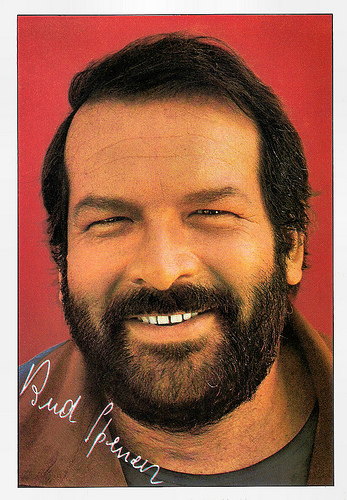
German autograph card by BRAVO.
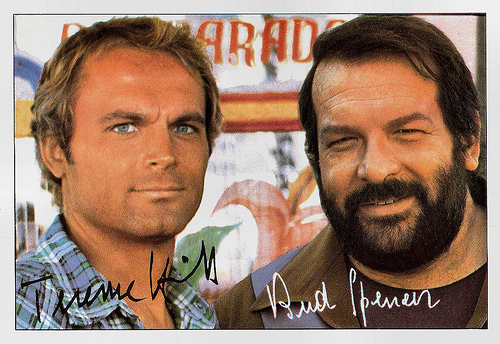
With Terence Hill . German autograph card by BRAVO.
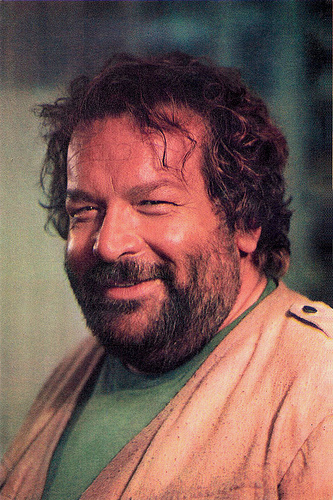
Italian postcard. Promotional card for Io Sto Con Gli Ippopotami/I'm for the Hippopotamus (Italo Zingarelli, 1979).
Bitten By the Acting Bug
Bud Spencer was born Carlo Pedersoli in Santa Lucia, a historical part of the city of Naples, in 1929.
He was educated as an attorney and holds a Juris Doctor degree, but Carlo was bitten by the acting bug. His first film role was that of a member of the Praetorian guard in the MGM epic Quo Vadis (Mervyn Leroy, 1951), shot in Italy.
During the 1950s, he appeared in minor parts in various films made for the Italian market, including Un eroe dei nostri tempi/A Hero of Our Times (Mario Monicelli, 1955) with Alberto Sordi .
Pedersoli was also a successful swimmer. In 1950, he was the first Italian to swim the 100 m freestyle in less than one minute (59.5 s). In the 1951 Mediterranean Games, he won a silver medal in the same 100 m freestyle event.
He participated in the 1952 Olympic Games in Helsinki, Finland, reaching the semi-finals in the 100 m freestyle (58.8 s heats, 58.9 s semi final). Four years later, in Melbourne, he also entered the semi-finals in the same category (58.5 s heat, 59.0 s semi final).
As a water polo player, he won the Italian Championship in 1954, with S.S. Lazio. His swimming career ended abruptly in 1957.
He appeared in some more Italian films such as Annibale/Hannibal (Carlo Ludovico Bragaglia, Edgar G. Ulmer, 1959) starring Victor Mature, but his film career stayed minor league.
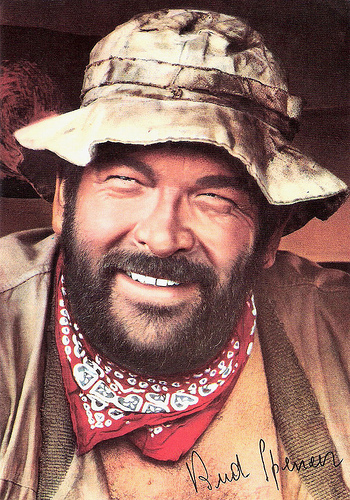
Italian postcard by Alterocca, Ferni.
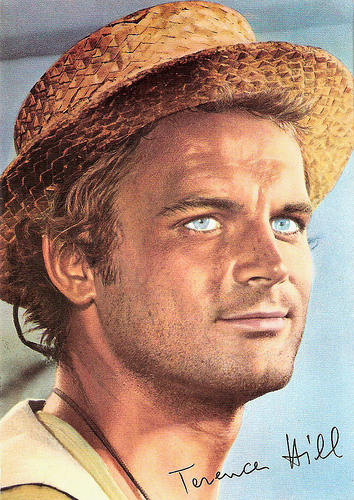
Terence Hill . Italian postcard by Alterocca, Ferni.
God Forgives... I Don't!
In 1967 Carlo Pedersoli changed his screen name to Bud Spencer. Reportedly he chose this pseudonym to pay homage to Hollywood star Spencer Tracy as well as his favourite Czech American beer, Budweiser. Other sources report that he found it funny to call himself ‘Bud’ despite his weight and his height at 1.94 m.
With Terence Hill a.k.a. Mario Girotti , he appeared in the Spaghetti Western Dio perdona... Io no!/God Forgives... I Don't! (Giuseppe Colizzi, 1967).
Their pairing was a coincidence while a foot injury had forced lead actor Peter Martell (Pietro Martellanza) off the picture. Terence Hill took over the part of the pistolero Cat Stevens, and the rest is history.
Their dual outings made both stars famous, particularly in Europe. At IMDb , reviewer Benjamin Gauss calls it one of their best films: “Although the movie has many gags and humorous parts, God Forgives... I Don't! is not one of the usual Spencer/Hill comedies, but a pretty brutal and rather serious Spaghetti Western”. However, it wasn’t their first film together, because both had also appeared in Annibale/Hannibal (1959).
After the success of Dio perdona... Io no! followed such westerns as I quattro dell'Ave Maria/Ace High (Giuseppe Colizzi, 1967) with Eli Wallach, and La collina degli stivali/Boot Hill (Giuseppe Colizzi, 1969) with Woody Strode.
Then they played two brothers in Lo chiamavano Trinità.../They Call Me Trinity (Enzo Barboni a.k.a. E.B. Clucher, 1970), a comedic spoof of the Spaghetti Western genre. The enormous success lead to the sequel ...continuavano a chiamarlo Trinità/Trinity Is STILL My Name! (Enzo Barboni, 1971) with Harry Carey Jr.
Most of these films have alternate titles, depending upon the country and distributor. Some have longer Italian versions that were edited for release abroad. Hill and Spencer also appeared together in other action genres, such as in the pirate adventure Il corsaro nero/Blackie the Pirate (Lorenzo Gicca Palli, 1971), the action film ...Altrimenti ci arrabbiamo!/Watch Out, We're Mad (Marcello Fondato, 1974) with Donald Pleasence, and another actioner I due superpiedi quasi piatti/Crime Busters (Enzo Barboni, 1977).
Practically all of Spencer's roles have him playing a bearded, balding, and brawny omnipotent who usually ends a fist fight by striking a hammer-like blow on the top of his opponent's head.
Romanian postcard by Casa Filmului Acin. Photo: publicity still for Continuavano a chiamarlo Trinità/Trinity is still my name (Enzo Barboni a.k.a. E.B. Clucher, 1971) with Terence Hill .
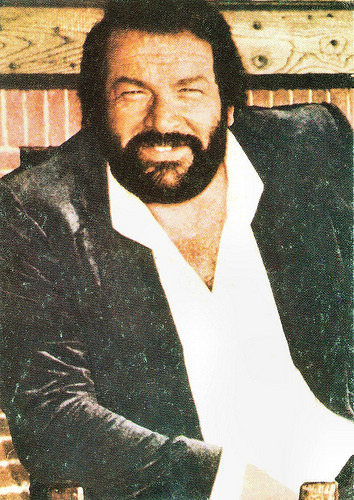
Romanian postcard by Casa Filmului Acin, no. 53189.
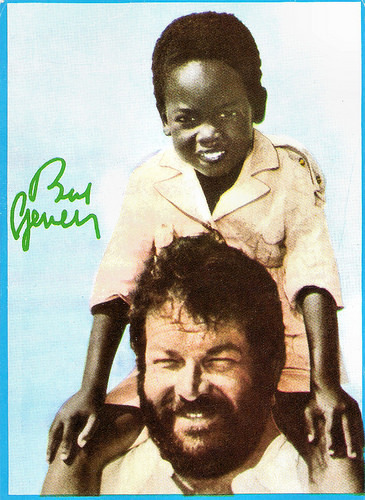
Romanian postcard by Casa Filmului Acin, no. 43 157. Photo: publicity still for Piedone l'africano/The knock-out cop (Steno, 1978) with Baldwin Dakile.
Extralarge
Bud Spencer also appeared solo in many films. He played in the Spaghetti Westerns Oggi a me... domani a te!/Today It's Me (Tonino Cervi, 1968) starring Brett Halsey aka Montgomery Ford, and Un esercito di cinque uomini/The Five Man Army (Don Taylor, Italo Zingarelli, 1969) with Peter Graves.
He made a rare entry in the horror genre in 4 mosche di velluto grigio/4 Flies on Grey Velvet (Dario Argento, 1971) with Mimsy Farmer. Then Spencer played a dramatic role as a man innocently kept in prison in Torino nera/Black Turin (Carlo Lizzani, 1972) with Françoise Fabian as his wife.
Later films include the action-packed potboilers Piedone lo sbirro/Piedone, the cop (Steno, 1973), and Lo chiamavano Bulldozer/They Call Him Bulldozer (Michele Lupo, 1978) with Raimund Harmstorf . Spencer also wrote the complete or partial screenplay for some of his films.
His feature film career slowed down after 1983, shifting more toward television. He also became a jet airplane and helicopter pilot in 1972. He established Mistral Air in 1984, an air-mail company that also transported pilgrims. He later sold it to Poste Italiane to buy a textile mill that produced clothes for children. He also has registered several patents.
In the 1990s he acted on TV in the comic action series Extralarge (Enzo G. Castellari, 1990-1993) and Noi siamo angeli/We Are Angels (Ruggero Deodato, 1997), both with Philip Michael Thomas, best known from the 1980s TV hit Miami Vice.
His final film with Terence Hill was Botte di Natale/Troublemakers (Terence Hill, 1994).
In 2005, Pedersoli entered politics, unsuccessfully standing as regional counsellor in Lazio for the centre-right Forza Italia party. That same year he was awarded with the Caimano d'oro (Gold Caiman) by the Italian Swimming Federation. Two years later, he received swim and water polo coach diplomas from the Italian Swimming Federation's president Paolo Barelli.
Bud Spencer continues to appear on TV. Recently he could be seen in the Italian Giallo-comedy television series I delitti del cuoco/Recipe for Crime (Alessandro Capone, 2010) and in an episode of the American comedy series Ninja the Mission Force (2013) .
Since 1960, Carlo Pedersoli is married to Maria Amato. They have three children: Giuseppe (1961), Christine (1962) and Diamante (1972).
Trailer of I quattro dell'Ave Maria/Ace High (1968). Source: spencerhilltrailer (YouTube).
Trailer of ...continuavano a chiamarlo Trinità/Trinity Is STILL My Name! (1971). Source: spencerhilltrailer (YouTube).
Trailer of Non c'è due senza quattro/Double Trouble (1984, Enzo Barboni). Source: spencerhilltrailer (YouTube).
Sources: (IMDb), Sandra Brennan (AllMovie), Wikipedia, and .

German autograph card by BRAVO.

With Terence Hill . German autograph card by BRAVO.

Italian postcard. Promotional card for Io Sto Con Gli Ippopotami/I'm for the Hippopotamus (Italo Zingarelli, 1979).
Bitten By the Acting Bug
Bud Spencer was born Carlo Pedersoli in Santa Lucia, a historical part of the city of Naples, in 1929.
He was educated as an attorney and holds a Juris Doctor degree, but Carlo was bitten by the acting bug. His first film role was that of a member of the Praetorian guard in the MGM epic Quo Vadis (Mervyn Leroy, 1951), shot in Italy.
During the 1950s, he appeared in minor parts in various films made for the Italian market, including Un eroe dei nostri tempi/A Hero of Our Times (Mario Monicelli, 1955) with Alberto Sordi .
Pedersoli was also a successful swimmer. In 1950, he was the first Italian to swim the 100 m freestyle in less than one minute (59.5 s). In the 1951 Mediterranean Games, he won a silver medal in the same 100 m freestyle event.
He participated in the 1952 Olympic Games in Helsinki, Finland, reaching the semi-finals in the 100 m freestyle (58.8 s heats, 58.9 s semi final). Four years later, in Melbourne, he also entered the semi-finals in the same category (58.5 s heat, 59.0 s semi final).
As a water polo player, he won the Italian Championship in 1954, with S.S. Lazio. His swimming career ended abruptly in 1957.
He appeared in some more Italian films such as Annibale/Hannibal (Carlo Ludovico Bragaglia, Edgar G. Ulmer, 1959) starring Victor Mature, but his film career stayed minor league.

Italian postcard by Alterocca, Ferni.

Terence Hill . Italian postcard by Alterocca, Ferni.
God Forgives... I Don't!
In 1967 Carlo Pedersoli changed his screen name to Bud Spencer. Reportedly he chose this pseudonym to pay homage to Hollywood star Spencer Tracy as well as his favourite Czech American beer, Budweiser. Other sources report that he found it funny to call himself ‘Bud’ despite his weight and his height at 1.94 m.
With Terence Hill a.k.a. Mario Girotti , he appeared in the Spaghetti Western Dio perdona... Io no!/God Forgives... I Don't! (Giuseppe Colizzi, 1967).
Their pairing was a coincidence while a foot injury had forced lead actor Peter Martell (Pietro Martellanza) off the picture. Terence Hill took over the part of the pistolero Cat Stevens, and the rest is history.
Their dual outings made both stars famous, particularly in Europe. At IMDb , reviewer Benjamin Gauss calls it one of their best films: “Although the movie has many gags and humorous parts, God Forgives... I Don't! is not one of the usual Spencer/Hill comedies, but a pretty brutal and rather serious Spaghetti Western”. However, it wasn’t their first film together, because both had also appeared in Annibale/Hannibal (1959).
After the success of Dio perdona... Io no! followed such westerns as I quattro dell'Ave Maria/Ace High (Giuseppe Colizzi, 1967) with Eli Wallach, and La collina degli stivali/Boot Hill (Giuseppe Colizzi, 1969) with Woody Strode.
Then they played two brothers in Lo chiamavano Trinità.../They Call Me Trinity (Enzo Barboni a.k.a. E.B. Clucher, 1970), a comedic spoof of the Spaghetti Western genre. The enormous success lead to the sequel ...continuavano a chiamarlo Trinità/Trinity Is STILL My Name! (Enzo Barboni, 1971) with Harry Carey Jr.
Most of these films have alternate titles, depending upon the country and distributor. Some have longer Italian versions that were edited for release abroad. Hill and Spencer also appeared together in other action genres, such as in the pirate adventure Il corsaro nero/Blackie the Pirate (Lorenzo Gicca Palli, 1971), the action film ...Altrimenti ci arrabbiamo!/Watch Out, We're Mad (Marcello Fondato, 1974) with Donald Pleasence, and another actioner I due superpiedi quasi piatti/Crime Busters (Enzo Barboni, 1977).
Practically all of Spencer's roles have him playing a bearded, balding, and brawny omnipotent who usually ends a fist fight by striking a hammer-like blow on the top of his opponent's head.
Romanian postcard by Casa Filmului Acin. Photo: publicity still for Continuavano a chiamarlo Trinità/Trinity is still my name (Enzo Barboni a.k.a. E.B. Clucher, 1971) with Terence Hill .

Romanian postcard by Casa Filmului Acin, no. 53189.

Romanian postcard by Casa Filmului Acin, no. 43 157. Photo: publicity still for Piedone l'africano/The knock-out cop (Steno, 1978) with Baldwin Dakile.
Extralarge
Bud Spencer also appeared solo in many films. He played in the Spaghetti Westerns Oggi a me... domani a te!/Today It's Me (Tonino Cervi, 1968) starring Brett Halsey aka Montgomery Ford, and Un esercito di cinque uomini/The Five Man Army (Don Taylor, Italo Zingarelli, 1969) with Peter Graves.
He made a rare entry in the horror genre in 4 mosche di velluto grigio/4 Flies on Grey Velvet (Dario Argento, 1971) with Mimsy Farmer. Then Spencer played a dramatic role as a man innocently kept in prison in Torino nera/Black Turin (Carlo Lizzani, 1972) with Françoise Fabian as his wife.
Later films include the action-packed potboilers Piedone lo sbirro/Piedone, the cop (Steno, 1973), and Lo chiamavano Bulldozer/They Call Him Bulldozer (Michele Lupo, 1978) with Raimund Harmstorf . Spencer also wrote the complete or partial screenplay for some of his films.
His feature film career slowed down after 1983, shifting more toward television. He also became a jet airplane and helicopter pilot in 1972. He established Mistral Air in 1984, an air-mail company that also transported pilgrims. He later sold it to Poste Italiane to buy a textile mill that produced clothes for children. He also has registered several patents.
In the 1990s he acted on TV in the comic action series Extralarge (Enzo G. Castellari, 1990-1993) and Noi siamo angeli/We Are Angels (Ruggero Deodato, 1997), both with Philip Michael Thomas, best known from the 1980s TV hit Miami Vice.
His final film with Terence Hill was Botte di Natale/Troublemakers (Terence Hill, 1994).
In 2005, Pedersoli entered politics, unsuccessfully standing as regional counsellor in Lazio for the centre-right Forza Italia party. That same year he was awarded with the Caimano d'oro (Gold Caiman) by the Italian Swimming Federation. Two years later, he received swim and water polo coach diplomas from the Italian Swimming Federation's president Paolo Barelli.
Bud Spencer continues to appear on TV. Recently he could be seen in the Italian Giallo-comedy television series I delitti del cuoco/Recipe for Crime (Alessandro Capone, 2010) and in an episode of the American comedy series Ninja the Mission Force (2013) .
Since 1960, Carlo Pedersoli is married to Maria Amato. They have three children: Giuseppe (1961), Christine (1962) and Diamante (1972).
Trailer of I quattro dell'Ave Maria/Ace High (1968). Source: spencerhilltrailer (YouTube).
Trailer of ...continuavano a chiamarlo Trinità/Trinity Is STILL My Name! (1971). Source: spencerhilltrailer (YouTube).
Trailer of Non c'è due senza quattro/Double Trouble (1984, Enzo Barboni). Source: spencerhilltrailer (YouTube).
Sources: (IMDb), Sandra Brennan (AllMovie), Wikipedia, and .
Published on February 02, 2015 22:00
February 1, 2015
Annie van Ees
Dutch stage and film actress Annie van Ees (1893-1970) was famous for her cross dressing role as Boefje (Little Rascal). She played Boefje 1500 times on stage and in 1939 in the film version by Douglas Sirk. It was her only film. She was also known as Annie van der Lugt Melsert-Van Ees through her marriage to noted stage director Cor van der Lugt Melsert.

Dutch postcard by Weenenk & Snel, Den Haag. Photo: Willem Coret, Den Haag (The Hague).
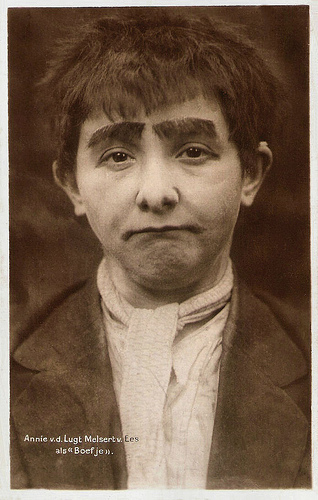
Dutch postcard by Weenenk & Snel, Den Haag. Photo: Willem Coret. Still for the stage version of Boefje.
Fashionable ladies and boys
Johanna Martina 'Annie' van Ees was born in Leiden in 1893. She was born into a family with five children. Her brothers, Henri van Ees and Jan van Ees , also became actors.
From early on, she knew that she wanted to be an actress, and she attended an acting school. At 17, she made her stage debuut in the play Schakels/Links by Herman Heijermans.
She joined the theatre company Het Tooneel and appeared in plays like ‘t Cafétje/The Small Café (1912) by Tristan Bernard.
Later, she was discovered by the famous stage director Cor van der Lugt Melsert and she joined his renowned company Nederlandsch Tooneel. In 1919 the two married, and they would have one son, Cor jr.
From 1922 till 1938, Annie worked for the theatre company Vereenigd Rotterdamsch-Hofstad Tooneel. She played fashionable ladies, young girls and even boys.
In 1923 she played thus the title role in the play that made her famous, Boefje/Little Rascal based on the novel by M.J. Brusse. She would appear more than 1500 times in this play.
She also performed regularly in the Dutch Indies (now Indonesia). Another success was Leontientje, which premiered in 1926.
With her brother Jan van Ees, she appeared in the plays Men trouwt geen meisjes zonder geld (Without Money One Doesn’t Marry Girls) (1929) by István Zagon, Mélo (1930) by Henry Bernstein and, De keizer van Amerika (The Apple Cart) (1930) by George Bernhard Shaw.
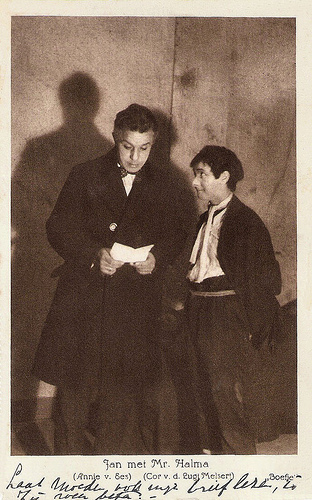
Dutch postcard by N.V. Vereenigd Rotterdamsch Hofstadtoneel, Rotterdam. Photo: Willem Coret. Still for the stage version of Boefje.
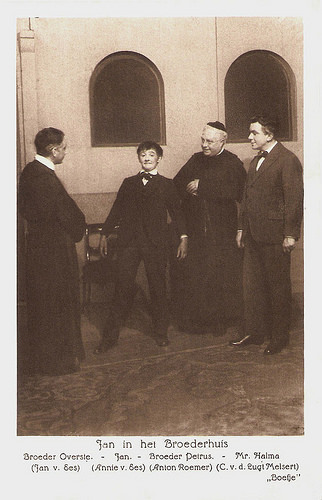
Dutch postcard by Vereenigd Rotterdamsch Hofstadtooneel. Photo: Willem Coret, The Hague. Publicity still for the stage play Boefje (1922). Caption: "Jan in the brother house".
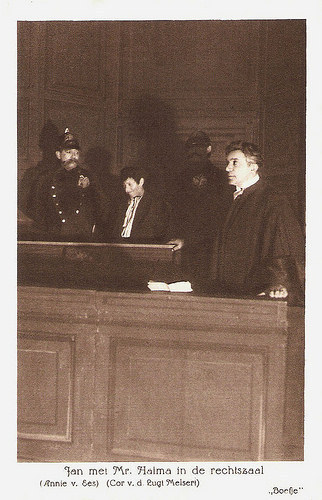
Dutch postcard by Vereenigd Rotterdamsch Hofstadtooneel. Photo: Coret, The Hague. Publicity still for the stage play Boefje (1922). Caption: "Jan with Mr. Halma in the courtroom".
Grande Dame
During the 1930s, Annie van Ees became one of the grande dames of the Dutch stage. After she left the Vereenigd Rotterdamsch-Hofstad Tooneel, she was offered the lead role in the film version of Boefje/Wilton's Zoo (Detlef Sierck aka Douglas Sirk, 1939).
At 45, Annie played twelve year old Jan Grovers a.k.a. Boefje, who spends more time in the alleys of Rotterdam than with his family. Occasionally he looks after his tree younger sisters, all of whom are called Mientje. Together with his best friend and partner in crime Pietje Puk (Guus Brox) he plans to travel to America to get rich. When a local clergyman (Albert van Dalsum) takes pity on the boy and tries to teach him good manners, Boefje at first rebels. However, once he is sent to a strict boarding school, he takes an interest in music, specifically the pipe organ.
Douglas Sirk wrote the scenario himself together with Carl Zuckmayer, the script writer of Der blaue Engel/The Blue Angel (Josef von Sternberg, 1930) and several other classics.
Annie played the cigar smoking street kid now with a shortcut, but Sirk later told that he would have preferred to work with real children.
Later, Annie van Ees appeared on stage in the title role of Madame Bovary (1942), and in 1950 she retired from the theatre.
In 1970, one year after the death of her husband, Annie van Ees died in Morges, Switzerland. She was 76. In the city of Heerhugowaard a garden is named after her, and in Rotterdam she is honoured with the 'Annie van Eesstraat' (Annie van Ees street).
The film version of Boefje was actually chosen to compete in the very first Cannes Film Festival that was to be held in September of 1939, but the festival was cancelled when the war broke out.
However, during the 55th edition held in 2002 it was decided to screen the 7 nominated films from 1939, pitting Boefje against The Wizard of Oz, Goodbye Mr. Chips and others. The award eventually went to Cecil B. DeMille's Union Pacific.
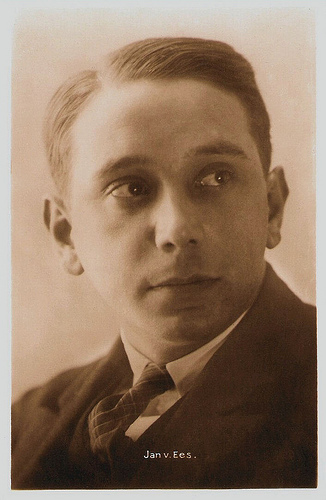
Annie's brother, Jan van Ees . Dutch postcard by Uitgave Weenenk & Snel, Den Haag. Photo: Willem Coret.

Dutch postcard. Photo: Willem Coret, Den Haag (The Hague).
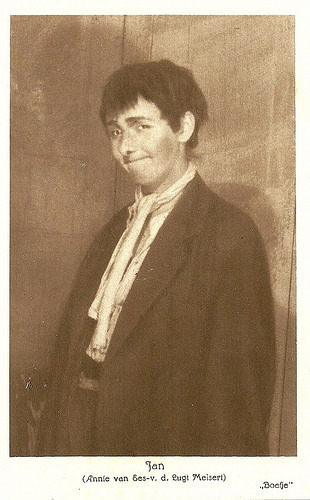
Dutch postcard by NV Vereenigd Rotterdamsch Hofstadtooneel. Photo: Coret, The Hague. Annie van Ees-van der Lugt Melsert in the stage play Boefje.
Sources: Chip Douglas (IMDb), Guido Franken (Neerlands Filmdoek - Dutch), Wikipedia (Dutch) and .

Dutch postcard by Weenenk & Snel, Den Haag. Photo: Willem Coret, Den Haag (The Hague).

Dutch postcard by Weenenk & Snel, Den Haag. Photo: Willem Coret. Still for the stage version of Boefje.
Fashionable ladies and boys
Johanna Martina 'Annie' van Ees was born in Leiden in 1893. She was born into a family with five children. Her brothers, Henri van Ees and Jan van Ees , also became actors.
From early on, she knew that she wanted to be an actress, and she attended an acting school. At 17, she made her stage debuut in the play Schakels/Links by Herman Heijermans.
She joined the theatre company Het Tooneel and appeared in plays like ‘t Cafétje/The Small Café (1912) by Tristan Bernard.
Later, she was discovered by the famous stage director Cor van der Lugt Melsert and she joined his renowned company Nederlandsch Tooneel. In 1919 the two married, and they would have one son, Cor jr.
From 1922 till 1938, Annie worked for the theatre company Vereenigd Rotterdamsch-Hofstad Tooneel. She played fashionable ladies, young girls and even boys.
In 1923 she played thus the title role in the play that made her famous, Boefje/Little Rascal based on the novel by M.J. Brusse. She would appear more than 1500 times in this play.
She also performed regularly in the Dutch Indies (now Indonesia). Another success was Leontientje, which premiered in 1926.
With her brother Jan van Ees, she appeared in the plays Men trouwt geen meisjes zonder geld (Without Money One Doesn’t Marry Girls) (1929) by István Zagon, Mélo (1930) by Henry Bernstein and, De keizer van Amerika (The Apple Cart) (1930) by George Bernhard Shaw.

Dutch postcard by N.V. Vereenigd Rotterdamsch Hofstadtoneel, Rotterdam. Photo: Willem Coret. Still for the stage version of Boefje.

Dutch postcard by Vereenigd Rotterdamsch Hofstadtooneel. Photo: Willem Coret, The Hague. Publicity still for the stage play Boefje (1922). Caption: "Jan in the brother house".

Dutch postcard by Vereenigd Rotterdamsch Hofstadtooneel. Photo: Coret, The Hague. Publicity still for the stage play Boefje (1922). Caption: "Jan with Mr. Halma in the courtroom".
Grande Dame
During the 1930s, Annie van Ees became one of the grande dames of the Dutch stage. After she left the Vereenigd Rotterdamsch-Hofstad Tooneel, she was offered the lead role in the film version of Boefje/Wilton's Zoo (Detlef Sierck aka Douglas Sirk, 1939).
At 45, Annie played twelve year old Jan Grovers a.k.a. Boefje, who spends more time in the alleys of Rotterdam than with his family. Occasionally he looks after his tree younger sisters, all of whom are called Mientje. Together with his best friend and partner in crime Pietje Puk (Guus Brox) he plans to travel to America to get rich. When a local clergyman (Albert van Dalsum) takes pity on the boy and tries to teach him good manners, Boefje at first rebels. However, once he is sent to a strict boarding school, he takes an interest in music, specifically the pipe organ.
Douglas Sirk wrote the scenario himself together with Carl Zuckmayer, the script writer of Der blaue Engel/The Blue Angel (Josef von Sternberg, 1930) and several other classics.
Annie played the cigar smoking street kid now with a shortcut, but Sirk later told that he would have preferred to work with real children.
Later, Annie van Ees appeared on stage in the title role of Madame Bovary (1942), and in 1950 she retired from the theatre.
In 1970, one year after the death of her husband, Annie van Ees died in Morges, Switzerland. She was 76. In the city of Heerhugowaard a garden is named after her, and in Rotterdam she is honoured with the 'Annie van Eesstraat' (Annie van Ees street).
The film version of Boefje was actually chosen to compete in the very first Cannes Film Festival that was to be held in September of 1939, but the festival was cancelled when the war broke out.
However, during the 55th edition held in 2002 it was decided to screen the 7 nominated films from 1939, pitting Boefje against The Wizard of Oz, Goodbye Mr. Chips and others. The award eventually went to Cecil B. DeMille's Union Pacific.

Annie's brother, Jan van Ees . Dutch postcard by Uitgave Weenenk & Snel, Den Haag. Photo: Willem Coret.

Dutch postcard. Photo: Willem Coret, Den Haag (The Hague).

Dutch postcard by NV Vereenigd Rotterdamsch Hofstadtooneel. Photo: Coret, The Hague. Annie van Ees-van der Lugt Melsert in the stage play Boefje.
Sources: Chip Douglas (IMDb), Guido Franken (Neerlands Filmdoek - Dutch), Wikipedia (Dutch) and .
Published on February 01, 2015 22:00
January 31, 2015
Owen Nares
British actor Owen Nares (1888-1943) was the heartthrob actor of his generation, both in films and on stage in the West End. The later 1910s and early 1920s were his golden period and he romanced such British film stars as Isobel Elsom and Lilian Hall-Davis. During the 1930s he became a character actor. Besides his acting career, he was the author of Myself, and Some Others (1925).
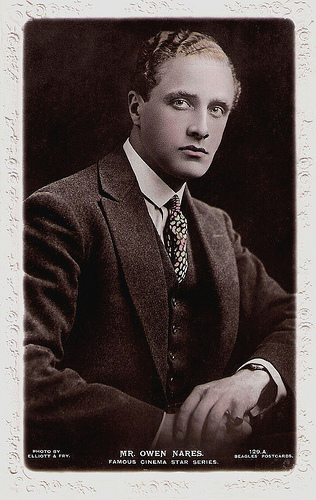
British postcard in the Famous Cinema Star Series by J. Beagles & Co., London. Photo: Elliott & Fry.
Blessed with good looks and a debonair manner
Owen Ramsay Nares was born in Maiden Erlegh, England in 1888. He was educated at Reading School.
Nares was encouraged by his mother to become an actor, and in 1908 he received his training from actress Rosina Filippi. The following year, he was playing bit parts in West End productions.
Blessed with good looks and a debonair manner, his reputation the as a matinee idol grew in the following years. In 1915, he played Thomas Armstrong in Edward Sheldon's Romance at the Lyric Theatre, and in 1917, he starred with Lily Elsie at the Palace Theatre in the musical comedy Pamela.
His delicate health strengthened the touch of romanticism which surrounded him. The silent production His Choice (Hubert von Herkomer, 1913) was the first of the 25 silent films in which Nares appeared.
His film debut was followed by Danny Donovan, the Gentleman Cracksman (Walter Waller, 1914) with Thomas Meighan and Gladys Cooper , the drama Milestones (Thomas Bentley, 1916) with Isobel Elsom, the romance Just a Girl (Alexander Butler, 1916) featuring Daisy Burrell, and The Labour Leader (Thomas Bentley, 1917) with Fay Compton.
During the early 1920s he acted as the handsome male lead opposite such popular film actresses as Isobel Elsom in the romantic drama For Her Father's Sake (Alexander Butler, 1921) and Lillian Hall-Davis in the romance Brown Sugar (Fred Paul, 1922) and in The Faithful Heart (Fred Paul, 1922).
His stage career also continued to flourish. He appeared opposite Meggie Albanesi in The First and the Last for a long-run during the 1920s. Nares continued to star in popular West End shows, almost without pause, until 1926, when he then took a break and set off with his own company for a tour of South Africa.
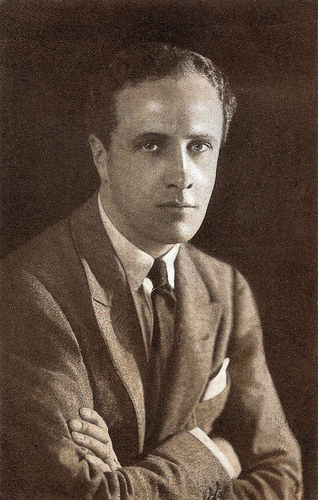
British postcard by John Waddington Ltd., Leeds / London. Photo: publicity still for the stage production of Diplomacy in the New Theatre, Cardiff. Sent by mail in 1924.
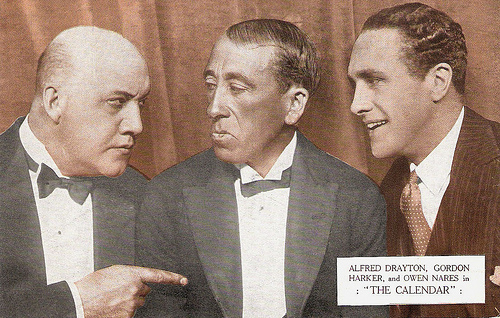
British postcard by S.C. Allen & Company, Ltd., Belfast and London for Wyndham's Theatre, London. Photo: publicity still for the play The Calendar (1931) with Gordon Harker , Alfred Drayton and Owen Nares.
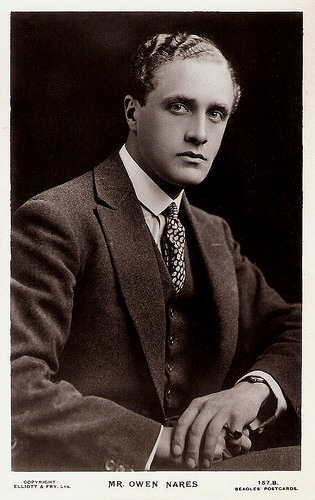
British postcard in the Famous Cinema Star Series by J. Beagles & Co., London. Photo: Elliott & Fry.
Still much in demand
With the advent of the sound film, Owen Nares’ considerable stage experience meant that he was still much in demand and starred in several early sound films. The first was the comedy The Middle Watch (Norman Walker, 1930) with Jacqueline Logan. It was made by British International Pictures at its Elstree Studios.
He appeared with Edna Best in the crime-drama Loose Ends (Norman Walker, 1930). A big hit was the musical Sunshine Susie (Victor Saville, 1931) starring Renate Müller , Jack Hulbert and Nares. The film established Müller as a star in Britain. An alternate German-language version, Die Privatsekretärin, was made, also starring Renate Müller but without Nares.
The Impassive Footman (Basil Dean, 1932)was a low-budget ‘quota quickie’ in which he co-starred with Betty Stockfeld. This drama was made at Ealing Studios and was also released under the alternative title Woman in Bondage.
Nares co-starred with Winifred Shotter in the musical The Love Contract (Herbert Selpin, 1932). He appeared opposite Jessie Matthews in the comedy There Goes the Bride (Albert de Courville, 1932). He was, however, too mature to be the handsome star he had been a decade earlier.
In the last six films he made, he played supporting roles. Remarkable is the comedy-drama The Private Life of Don Juan (Alexander Korda, 1934) starring Douglas Fairbanks in his final film role as the aging Don Juan. In the musical The Show Goes On (Basil Dean, 1937), he was the co-star of Gracie Fields .
His final film was The Prime Minister (Thorold Dickinson, 1941) about the life and times of novelist Benjamin Disraeli ( John Gielgud ), who became Prime Minister of the United Kingdom.
In 1942, Nares appeared in a revival of Robert E. Sherwood’s The Petrified Forrest, and afterwards he went on tour with the play to Northern England and Wales.
During a tour through Wales in 1943, he visited Brecon, and the birthplace of actress Sarah Siddons. While he was in the very room where Siddons had been born, Nares had a heart attack and died shortly afterwards in 1943. He was 54.
Since 1910, Owen Nares was married to Anglo-Italian actress Marie Pollini. The couple had two sons, David and Geoffrey Nares. During the war, Geoffrey died in Egypt in 1942.
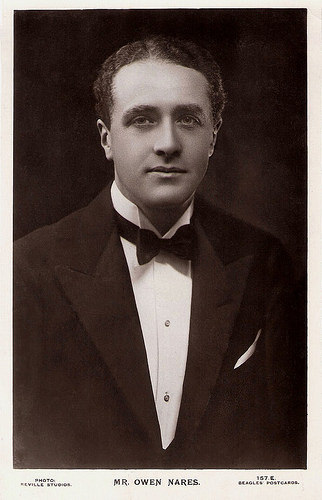
British postcard by Beagles & Co., no. 157e. Photo: Reville Studios.
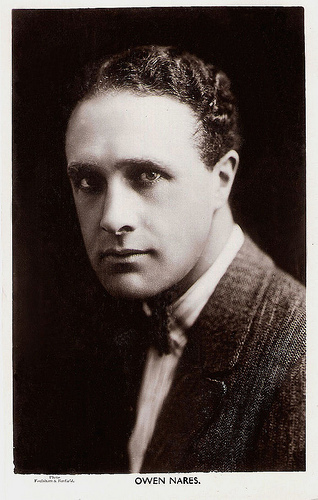
British postcard in the Picturegoer Series, London, no. 84. Photo: Foolsham & Banfield.
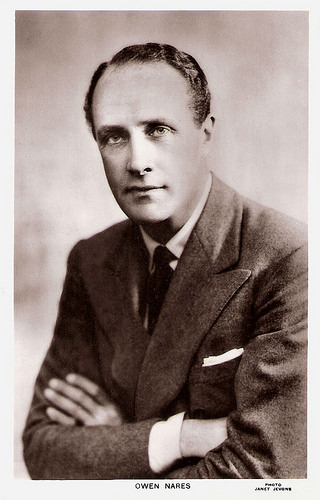
British postcard in the Picturegoer Series, London, no. 84c. Photo: Janet Jevons.
Sources: Bridget Clarke (St. John’s Wood Memories), Thomas Staedeli (Cyranos), AllMovie, Wikipedia, and .

British postcard in the Famous Cinema Star Series by J. Beagles & Co., London. Photo: Elliott & Fry.
Blessed with good looks and a debonair manner
Owen Ramsay Nares was born in Maiden Erlegh, England in 1888. He was educated at Reading School.
Nares was encouraged by his mother to become an actor, and in 1908 he received his training from actress Rosina Filippi. The following year, he was playing bit parts in West End productions.
Blessed with good looks and a debonair manner, his reputation the as a matinee idol grew in the following years. In 1915, he played Thomas Armstrong in Edward Sheldon's Romance at the Lyric Theatre, and in 1917, he starred with Lily Elsie at the Palace Theatre in the musical comedy Pamela.
His delicate health strengthened the touch of romanticism which surrounded him. The silent production His Choice (Hubert von Herkomer, 1913) was the first of the 25 silent films in which Nares appeared.
His film debut was followed by Danny Donovan, the Gentleman Cracksman (Walter Waller, 1914) with Thomas Meighan and Gladys Cooper , the drama Milestones (Thomas Bentley, 1916) with Isobel Elsom, the romance Just a Girl (Alexander Butler, 1916) featuring Daisy Burrell, and The Labour Leader (Thomas Bentley, 1917) with Fay Compton.
During the early 1920s he acted as the handsome male lead opposite such popular film actresses as Isobel Elsom in the romantic drama For Her Father's Sake (Alexander Butler, 1921) and Lillian Hall-Davis in the romance Brown Sugar (Fred Paul, 1922) and in The Faithful Heart (Fred Paul, 1922).
His stage career also continued to flourish. He appeared opposite Meggie Albanesi in The First and the Last for a long-run during the 1920s. Nares continued to star in popular West End shows, almost without pause, until 1926, when he then took a break and set off with his own company for a tour of South Africa.

British postcard by John Waddington Ltd., Leeds / London. Photo: publicity still for the stage production of Diplomacy in the New Theatre, Cardiff. Sent by mail in 1924.

British postcard by S.C. Allen & Company, Ltd., Belfast and London for Wyndham's Theatre, London. Photo: publicity still for the play The Calendar (1931) with Gordon Harker , Alfred Drayton and Owen Nares.

British postcard in the Famous Cinema Star Series by J. Beagles & Co., London. Photo: Elliott & Fry.
Still much in demand
With the advent of the sound film, Owen Nares’ considerable stage experience meant that he was still much in demand and starred in several early sound films. The first was the comedy The Middle Watch (Norman Walker, 1930) with Jacqueline Logan. It was made by British International Pictures at its Elstree Studios.
He appeared with Edna Best in the crime-drama Loose Ends (Norman Walker, 1930). A big hit was the musical Sunshine Susie (Victor Saville, 1931) starring Renate Müller , Jack Hulbert and Nares. The film established Müller as a star in Britain. An alternate German-language version, Die Privatsekretärin, was made, also starring Renate Müller but without Nares.
The Impassive Footman (Basil Dean, 1932)was a low-budget ‘quota quickie’ in which he co-starred with Betty Stockfeld. This drama was made at Ealing Studios and was also released under the alternative title Woman in Bondage.
Nares co-starred with Winifred Shotter in the musical The Love Contract (Herbert Selpin, 1932). He appeared opposite Jessie Matthews in the comedy There Goes the Bride (Albert de Courville, 1932). He was, however, too mature to be the handsome star he had been a decade earlier.
In the last six films he made, he played supporting roles. Remarkable is the comedy-drama The Private Life of Don Juan (Alexander Korda, 1934) starring Douglas Fairbanks in his final film role as the aging Don Juan. In the musical The Show Goes On (Basil Dean, 1937), he was the co-star of Gracie Fields .
His final film was The Prime Minister (Thorold Dickinson, 1941) about the life and times of novelist Benjamin Disraeli ( John Gielgud ), who became Prime Minister of the United Kingdom.
In 1942, Nares appeared in a revival of Robert E. Sherwood’s The Petrified Forrest, and afterwards he went on tour with the play to Northern England and Wales.
During a tour through Wales in 1943, he visited Brecon, and the birthplace of actress Sarah Siddons. While he was in the very room where Siddons had been born, Nares had a heart attack and died shortly afterwards in 1943. He was 54.
Since 1910, Owen Nares was married to Anglo-Italian actress Marie Pollini. The couple had two sons, David and Geoffrey Nares. During the war, Geoffrey died in Egypt in 1942.

British postcard by Beagles & Co., no. 157e. Photo: Reville Studios.

British postcard in the Picturegoer Series, London, no. 84. Photo: Foolsham & Banfield.

British postcard in the Picturegoer Series, London, no. 84c. Photo: Janet Jevons.
Sources: Bridget Clarke (St. John’s Wood Memories), Thomas Staedeli (Cyranos), AllMovie, Wikipedia, and .
Published on January 31, 2015 22:00
January 30, 2015
La Cuccagna (1917)
The Italian diva Hesperia was the star of the silent drama La Cuccagna/The Bonanza (Baldassarre Negroni, 1917). The film was an adaptation of Emile Zola's La curée. Hesperia is Renata/Renée, second wife of the cunning and wealthy Saccard, who married young Renata for her money. She has an affair with Saccard's son Max, played by Alberto Collo. In the end money triumphs over love, just as in Zola's novel.
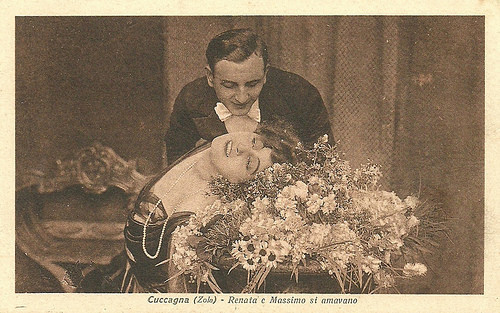
Italian postcard by IPA CT. V. Uff. Rev. St. Terni, no. 5070. Photo: Tiber Film. Caption: "Renata and Massimo love each other." Postcard for La Cuccagna (Baldassarre Negroni, 1917), starring Hesperia and Alberto Collo.
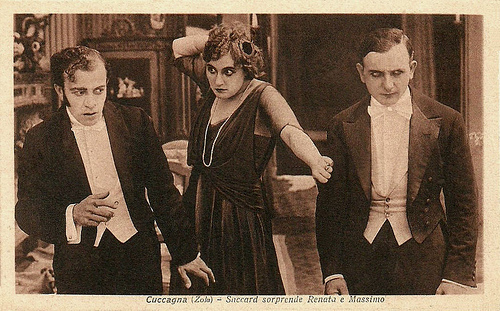
Italian postcard by IPA CT V. Uff. Rev. St. Terni, no. 5071. Photo: Tiber Film. Caption: "Saccard surprises Renata and Max Postcard for La Cuccagna (Baldassarre Negroni, 1917). On this postcard the father (Claudio Nicola at left) looks not much older than the son (Alberto Collo at right).
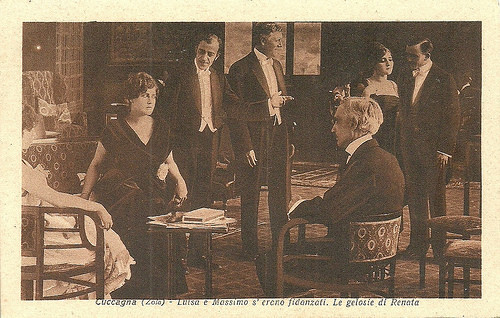
Italian postcard by IPA CT. V. Uff. Rev. St. Terni, no. 5072. Photo: Tiber Film. Caption: "Massimo and Luisa are betrothed. The jealousy of Renata." Postcard for La Cuccagna (Baldassarre Negroni, 1917), starring Hesperia.
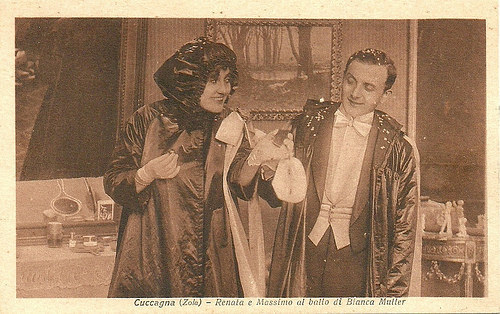
Italian postcard by IPA CT. V. Uff. Rev. St. Terni, no. 5073. Photo: Tiber Film. Caption: "Renata and Massimo at the ball of Bianca Muller." Postcard for La Cuccagna (Baldassarre Negroni, 1917), starring Hesperia and Alberto Collo.
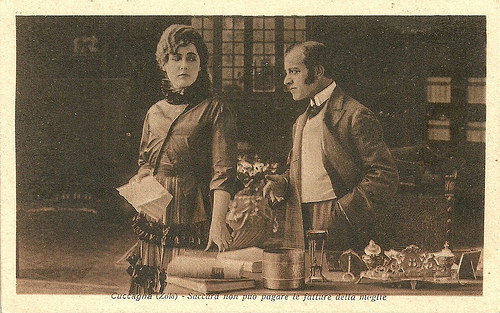
Italian postcard by IPA CT. V. Uff. Rev. St. Terni, no. 5074. Photo: Tiber Film. Caption: "Saccard cannot pay the bills of his wife anymore." Postcard for La Cuccagna (Baldassarre Negroni, 1917), starring Hesperia and Claudio Nicola.
Money triumphs over Love
Hesperia (1885-1959), was one of the divas of the Italian silent screen. She often worked with director Baldassarre Negroni, who later became her husband.
La Cuccagna was a liberal adaptation of Emile Zola's La curée, cutting Zola's socialist critique on bourgeois building speculation and nouveau riche under the Second Empire, and keeping the Phaedra-like, private intrigue of a triangular affair.
Hesperia is Renata/Renée, second wife of the cunning and wealthy Saccard (Claudio Nicola), originally Aristide Rougon, who married young Renata for her money, with Saccard's sister Sidonie as intermediate.
Years after, his son from his first marriage, Max/Massimo ( Alberto Collo ), develops an affair with his stepmother Renata - an affair which Saccard initially tolerates in exchange for Renata's inheritance. They claim to have an open marriage.
In the end money triumphs instead of love, just as in Zola's novel. Massimo is married to young Luisa (Diana d'Amore), the daughter of rich banker Mareuil ( Ignazio Lupi ), when Saccard claims he cannot pay Renata's bills anymore.
Renata is so shocked Massimo leaves her for wealth and youth she first maddens, then develops meningitis and dies.
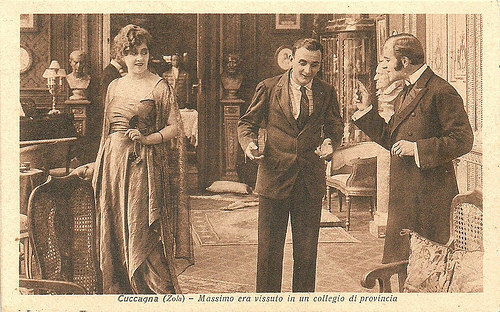
Italian postcard by IPA CT. V. Uff. Rev. St. Terni, no. 5076. Photo: Tiber Film. Caption: "Massimo had been raised in a provincial college." Postcard for La Cuccagna (Baldassarre Negroni, 1917), starring Hesperia, Alberto Collo and Claudio Nicola.
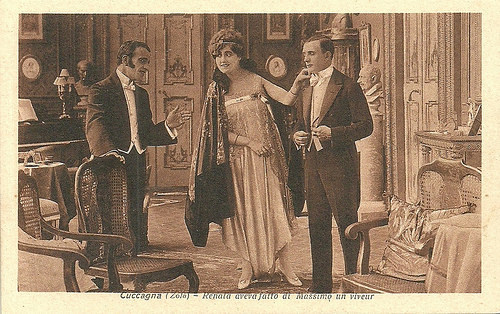
Italian postcard by IPA CT. V. Uff. Rev. St. Terni, no. 5077. Photo: Tiber Film. Caption: "Renata had turned Massimo in un 'viveur'." Postcard for La Cuccagna (Baldassarre Negroni, 1917), starring Claudio Nicola, Hesperia and Alberto Colla.
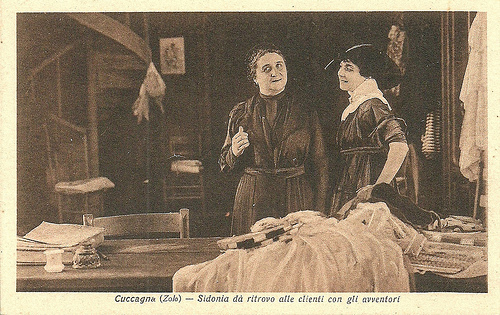
Italian postcard by IPA CT. V. Uff. Rev. St. Terni, no. 5078. Photo: Tiber Film. Caption: "Sidonia hosted meetings between her female and her male customers." Postcard for La Cuccagna (Baldassarre Negroni, 1917), starring Hesperia and Ida Carloni Talli as Sidonia.
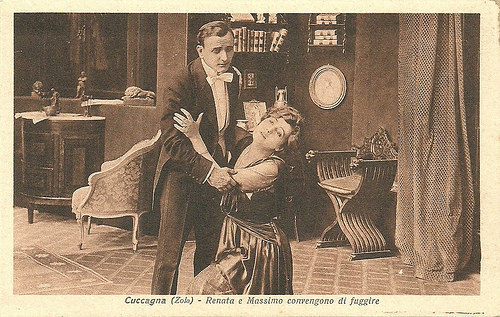
Italian postcard by IPA CT. V. Uff. Rev. St. Terni, no. 5079. Photo: Tiber Film. Caption: "Renata and Massimo agree to elope." Postcard for La Cuccagna (Baldassarre Negroni, 1917), starring Hesperia and Alberto Collo.
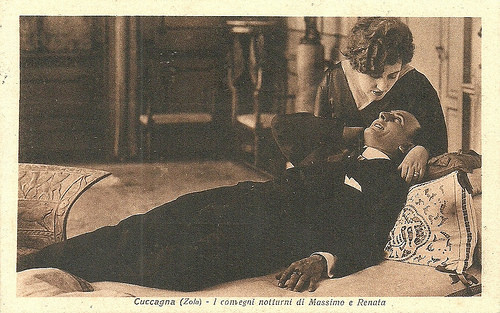
Italian postcard by IPA CT. V. Uff. Rev. St. Terni, no. 5080. Photo: Tiber Film. Caption: "The nocturnal meetings of Massimo and Renata." Postcard for La Cuccagna (Baldassarre Negroni, 1917), starring Hesperia and Alberto Collo.
How true are her heartbeats
In the Italian film journal La vita cinematografica (22/28.2.1917), Pier da Castello regretted the loss of the social critique but praised Hesperia 's performance:
"How naively she smiles, how heartily she laughs, how she knows to be tender, languid and mischievous!
How true are her heartbeats and her worries, how pathetic are her despairs, how sad and bitter her tears.
How true and human is her desperate rage! Hesperia does not act. She lives her part, defies every confrontation and surpasses any expectation.
Whoever sees her in La cuccagna must connect her with the female sovereigns of the gesture, among the silent actresses who unsurpassable know to express any emotion."
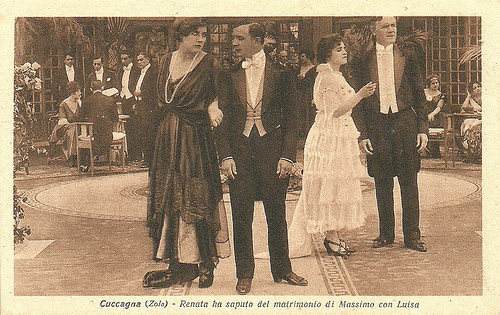
Italian postcard by IPA CT. V. Uff. Rev. St. Terni, no. 5081. Photo: Tiber Film. Caption: "Renata has heard about the wedding between Massimo and Luisa." Postcard for La Cuccagna (Baldassarre Negroni, 1917), starring Hesperia and Alberto Colla.
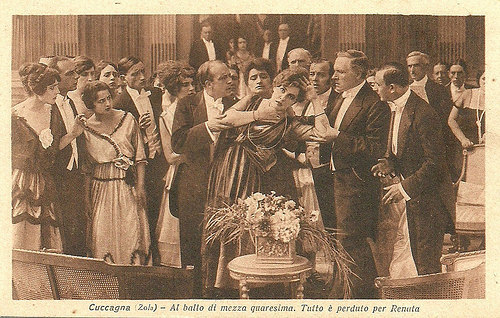
Italian postcard by IPA CT. V. Uff. Rev. St. Terni, no. 5082. Photo: Tiber Film. Caption: "At the Half Lent ball. All is lost for Renata." Postcard for La Cuccagna (Baldassarre Negroni, 1917), starring Hesperia.
Source: Vittorio Martinelli (Il Cinema Muto Italiano - Italian) and IMDb.

Italian postcard by IPA CT. V. Uff. Rev. St. Terni, no. 5070. Photo: Tiber Film. Caption: "Renata and Massimo love each other." Postcard for La Cuccagna (Baldassarre Negroni, 1917), starring Hesperia and Alberto Collo.

Italian postcard by IPA CT V. Uff. Rev. St. Terni, no. 5071. Photo: Tiber Film. Caption: "Saccard surprises Renata and Max Postcard for La Cuccagna (Baldassarre Negroni, 1917). On this postcard the father (Claudio Nicola at left) looks not much older than the son (Alberto Collo at right).

Italian postcard by IPA CT. V. Uff. Rev. St. Terni, no. 5072. Photo: Tiber Film. Caption: "Massimo and Luisa are betrothed. The jealousy of Renata." Postcard for La Cuccagna (Baldassarre Negroni, 1917), starring Hesperia.

Italian postcard by IPA CT. V. Uff. Rev. St. Terni, no. 5073. Photo: Tiber Film. Caption: "Renata and Massimo at the ball of Bianca Muller." Postcard for La Cuccagna (Baldassarre Negroni, 1917), starring Hesperia and Alberto Collo.

Italian postcard by IPA CT. V. Uff. Rev. St. Terni, no. 5074. Photo: Tiber Film. Caption: "Saccard cannot pay the bills of his wife anymore." Postcard for La Cuccagna (Baldassarre Negroni, 1917), starring Hesperia and Claudio Nicola.
Money triumphs over Love
Hesperia (1885-1959), was one of the divas of the Italian silent screen. She often worked with director Baldassarre Negroni, who later became her husband.
La Cuccagna was a liberal adaptation of Emile Zola's La curée, cutting Zola's socialist critique on bourgeois building speculation and nouveau riche under the Second Empire, and keeping the Phaedra-like, private intrigue of a triangular affair.
Hesperia is Renata/Renée, second wife of the cunning and wealthy Saccard (Claudio Nicola), originally Aristide Rougon, who married young Renata for her money, with Saccard's sister Sidonie as intermediate.
Years after, his son from his first marriage, Max/Massimo ( Alberto Collo ), develops an affair with his stepmother Renata - an affair which Saccard initially tolerates in exchange for Renata's inheritance. They claim to have an open marriage.
In the end money triumphs instead of love, just as in Zola's novel. Massimo is married to young Luisa (Diana d'Amore), the daughter of rich banker Mareuil ( Ignazio Lupi ), when Saccard claims he cannot pay Renata's bills anymore.
Renata is so shocked Massimo leaves her for wealth and youth she first maddens, then develops meningitis and dies.

Italian postcard by IPA CT. V. Uff. Rev. St. Terni, no. 5076. Photo: Tiber Film. Caption: "Massimo had been raised in a provincial college." Postcard for La Cuccagna (Baldassarre Negroni, 1917), starring Hesperia, Alberto Collo and Claudio Nicola.

Italian postcard by IPA CT. V. Uff. Rev. St. Terni, no. 5077. Photo: Tiber Film. Caption: "Renata had turned Massimo in un 'viveur'." Postcard for La Cuccagna (Baldassarre Negroni, 1917), starring Claudio Nicola, Hesperia and Alberto Colla.

Italian postcard by IPA CT. V. Uff. Rev. St. Terni, no. 5078. Photo: Tiber Film. Caption: "Sidonia hosted meetings between her female and her male customers." Postcard for La Cuccagna (Baldassarre Negroni, 1917), starring Hesperia and Ida Carloni Talli as Sidonia.

Italian postcard by IPA CT. V. Uff. Rev. St. Terni, no. 5079. Photo: Tiber Film. Caption: "Renata and Massimo agree to elope." Postcard for La Cuccagna (Baldassarre Negroni, 1917), starring Hesperia and Alberto Collo.

Italian postcard by IPA CT. V. Uff. Rev. St. Terni, no. 5080. Photo: Tiber Film. Caption: "The nocturnal meetings of Massimo and Renata." Postcard for La Cuccagna (Baldassarre Negroni, 1917), starring Hesperia and Alberto Collo.
How true are her heartbeats
In the Italian film journal La vita cinematografica (22/28.2.1917), Pier da Castello regretted the loss of the social critique but praised Hesperia 's performance:
"How naively she smiles, how heartily she laughs, how she knows to be tender, languid and mischievous!
How true are her heartbeats and her worries, how pathetic are her despairs, how sad and bitter her tears.
How true and human is her desperate rage! Hesperia does not act. She lives her part, defies every confrontation and surpasses any expectation.
Whoever sees her in La cuccagna must connect her with the female sovereigns of the gesture, among the silent actresses who unsurpassable know to express any emotion."

Italian postcard by IPA CT. V. Uff. Rev. St. Terni, no. 5081. Photo: Tiber Film. Caption: "Renata has heard about the wedding between Massimo and Luisa." Postcard for La Cuccagna (Baldassarre Negroni, 1917), starring Hesperia and Alberto Colla.

Italian postcard by IPA CT. V. Uff. Rev. St. Terni, no. 5082. Photo: Tiber Film. Caption: "At the Half Lent ball. All is lost for Renata." Postcard for La Cuccagna (Baldassarre Negroni, 1917), starring Hesperia.
Source: Vittorio Martinelli (Il Cinema Muto Italiano - Italian) and IMDb.
Published on January 30, 2015 22:00
January 29, 2015
Pier Angeli
Before she was 20 Pier Angeli (1932-1971) had starred with Vittorio de Sica in two Italian box office hits and was discovered by Hollywood. There she would win a Golden Globe, have an affair with James Dean, and there she would die before she was 40.
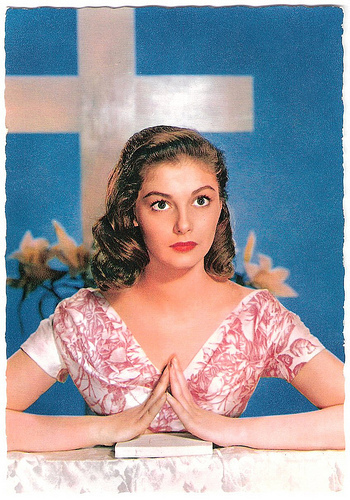
French postcard, no. 108.
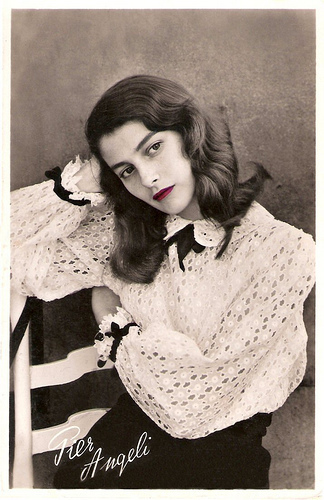
Dutch postcard by DRC, no. F 103. Photo: MGM.
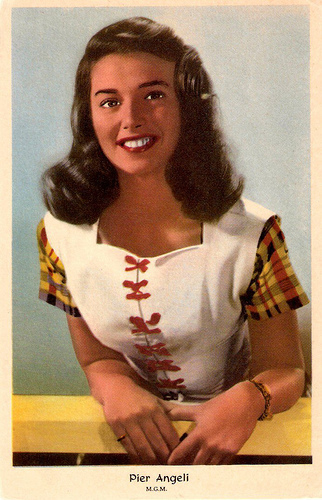
Dutch postcard. Photo: MGM.
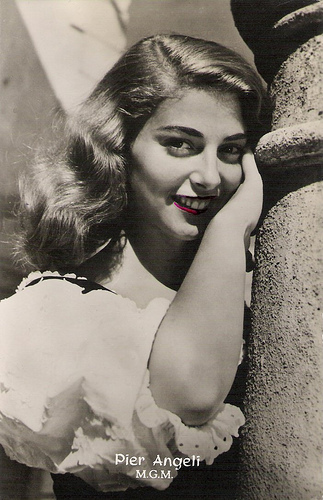
Dutch postcard.
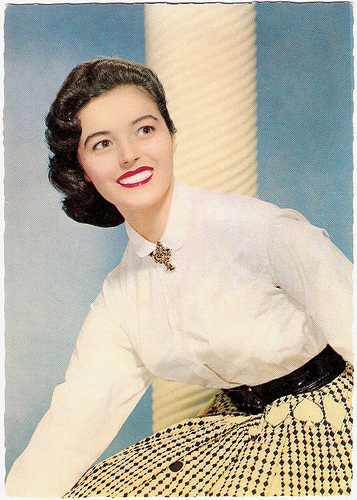
French postcard by Edition du Globe (E.D.U.G.), no. 93.
A Light Touch of Innocence
Anna Maria Pierangeli was born in 1932, in Cagliari on the island of Sardinia. Her twin sister is the actress Marisa Pavan .
When she was only 16 she made her film debut in an uncredited part in a short Italian film. The following year she played with Vittorio de Sica in Domani è troppo tardi/Tomorrow Is Too Late (Léonide Moguy, 1950).
At AllMovie , Hal Erickson writes: "Domani e Troppo Tardi is the first of two Leonide Moguy films dealing with the travails of post-war Italian life; the second was Domani e un altro Giorno. The story concerns the efforts to provide a proper sex education for youngsters. Progressive schoolteachers Landi ( Vittorio De Sica ) and Anna (Lois Maxwell) have a profound influence on two of their young students, Mirella (Anna Maria Pierangeli) and Franco (Gino Leuri). The two kids are enamored of one another, and decide to experiment with some of the knowledge they've gleaned in the classroom... with devastating results."
Soon Anna Maria Pierangeli would be discovered by Hollywood, and she changed her professional name in Pier Angeli. MGM launched her in Teresa (Fred Zinnemann, 1951). Enthusiastic reviews for her eloquent and understated performance compared her to Greta Garbo . She received an Oscar nomination and won a Golden Globe.
With Stewart Granger she played in The Light Touch (Richard Brooks, 1952). She indeed brought a light touch of innocence to the film, but her next films, like the musical The Story of Three Loves (Vincente Minnelli, Gottfried Reinhardt, 1953), and Flame and the Flesh (Richard Brooks, 1954) with Lana Turner, were respectable but unexciting.
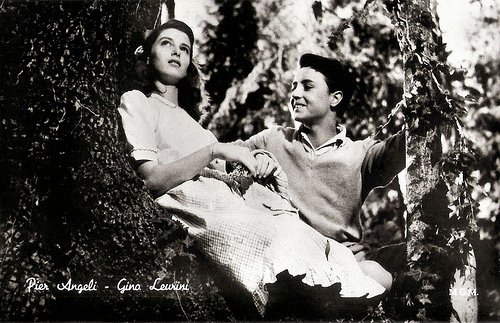
Italian postcard. Photo: M.G.M. Publicity still for Domani è troppo tardi/Tomorrow Is Too Late (Léonide Moguy, 1950) with Gino Leurini.
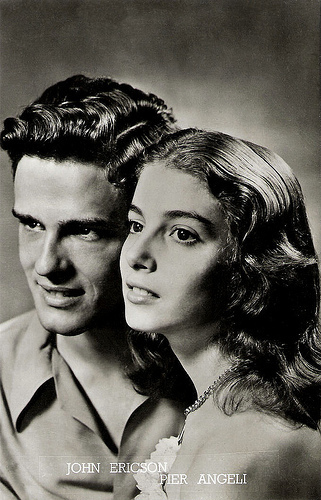
Belgian postcard, offered by RI RI Demaret, no. 1051. Photo: MGM. Publicity still for Teresa (Fred Zinnemann, 1951) with John Ericson.
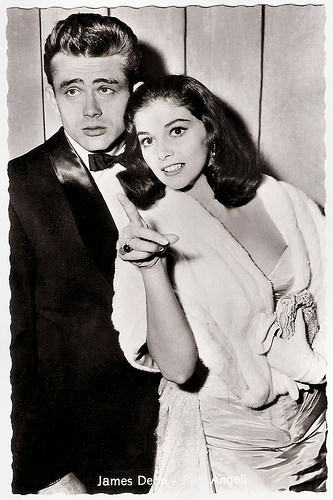
With James Dean. German postcard by Kolibri-Verlag, Minden/Westf., no. 2346. Photo: Keystone.
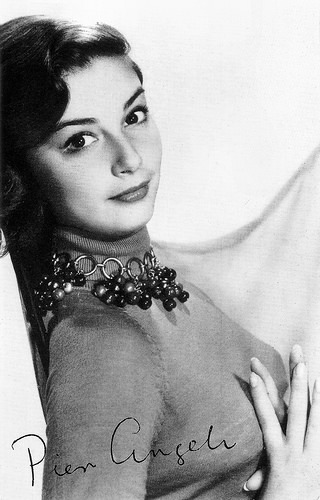
British postcard in the Film Star Autograph Portrait Series by L.D. Ltd., London, no. 133. Photo: M.G.M. Publicity still for Sombrero (Norman Foster, 1953).
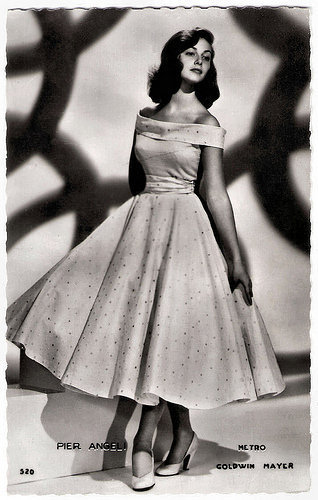
French postcard by Editions P.I., Paris, no. 520, offered by Les Carbones Korès 'Carboplane'. Photo: Metro-Goldwyn-Mayer, 1954.
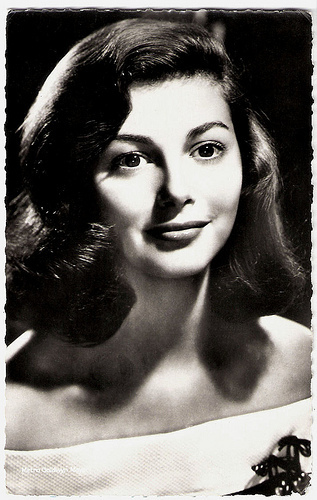
French postcard by Editions du Globe, no. 549. Photo: Metro-Goldwyn-Mayer.
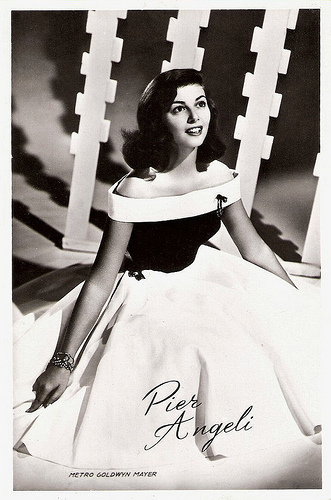
Dutch postcard by Takken, Utrecht, no. 1182. Photo: MGM.
The Angry Silence
Pier Angeli had a relationship with James Dean but in 1954, under pressure from her domineering mother, she married Catholic singer Vic Damone. The marriage lasted only four years and was followed by highly publicized court battles for the custody of their one son, Perry Farinola.
MGM discovered another European ingénue, Leslie Caron , and they loaned Pier out to other studios. At Warner Bros., she made The Silver Chalice (Victor Saville, 1954) which was only remarkable for the debut of Paul Newman.
For Paramount, she should have had the role of Anna Magnani 's daughter in The Rose Tattoo (Daniel Mann, 1955), but motherhood interfered. The role went to her twin sister, Marisa Pavan, who was nominated for an Oscar for it.
Pier returned to her old form in the biography of boxer Rocky Graziano, Somebody Up There Likes Me (Robert Wise, 1956) as Paul Newman's long-suffering wife.
During the 1960s she worked in Europe. She did a strong performance in the kitchen sink drama The Angry Silence (Guy Green, 1960) opposite Richard Attenborough , but few of her other films during that period were notable.
She was reunited with Stewart Granger for the sword and sandal epic Sodom and Gomorrah (Robert Aldrich, 1962) and she played a brief role in Battle of the Bulge (Ken Annakin, 1965) starring Henry Fonda .
Her final appearance was in the low-budget Sci-Fi opus Octaman (Harry Essex, 1971) opposite Kerwin Mathews.
She married a second time to composer Armando Trovaioli in 1962. They had a son, Andrew, but the couple divorced in 1969.
It seemed as if her acting career might revive when she was picked to play a role in The Godfather, (Francis Ford Coppola, 1972) but she died soon before filming.
On 10 September 1971 Pier Angeli was found dead of an accidental barbiturate overdose in her house in Beverly Hills. She was only 39 years old.
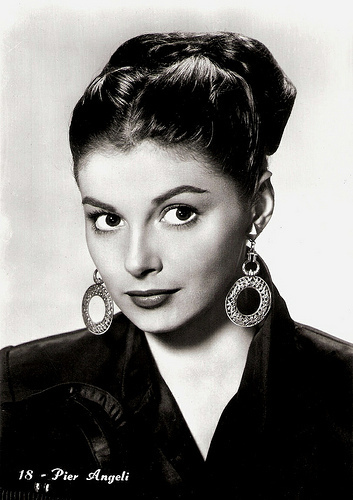
Italian postcard by Turismofoto, no. 18.
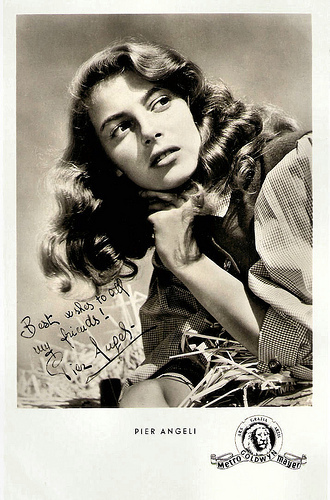
German postcard by Kunst und Bild, Berlin, no. A 370. Photo: M.G.M.
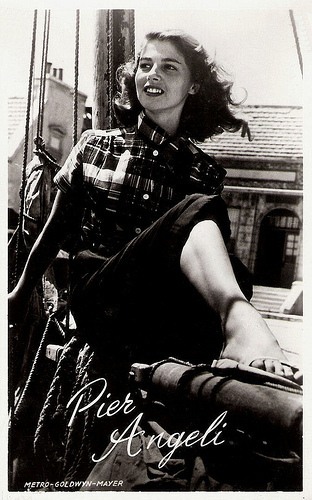
Dutch postcard. Photo: Metro-Goldwyn-Mayer (MGM).
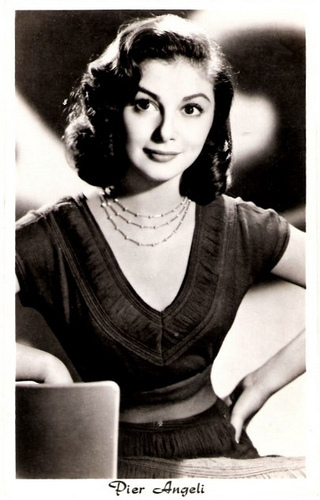
Indonesian postcard.
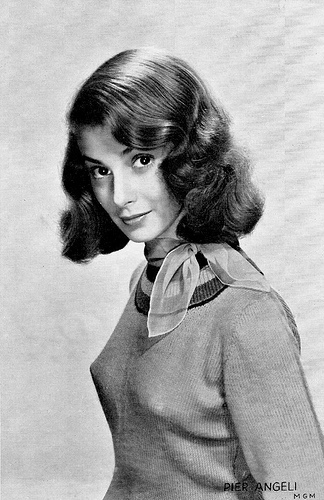
French postcard. Photo: MGM.
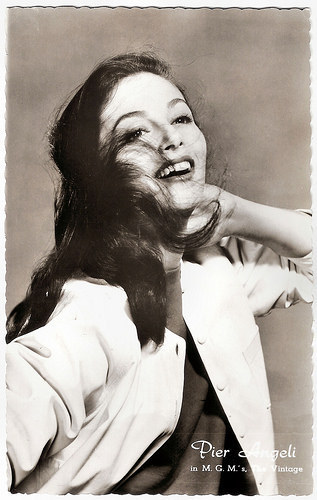
Dutch postcard. Photo: M.G.M. Publicity still for The Vintage (Jeffrey Hayden, 1957)
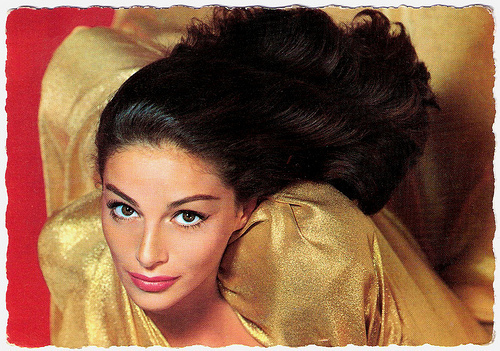
French postcard by E.D.U.G., no. 57.
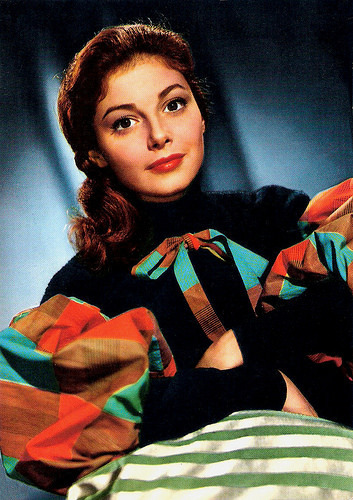
Italian postcard by Rotalfoto, Milano, no. 57.
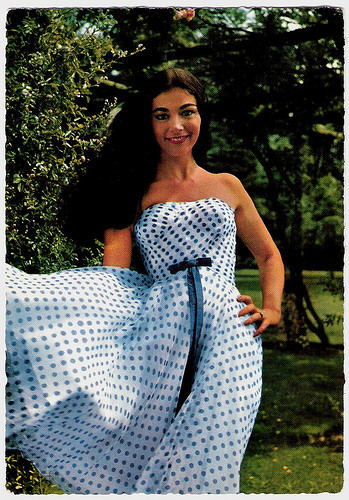
German postcard by Krüger, no. 902/48.
Scene from Domani è troppo tardi/Tomorrow Is Too Late (1950). Source: coralieshy (YouTube).
Sources: Hal Erickson (AllMovie), (IMDb), Wikipedia, and .

French postcard, no. 108.

Dutch postcard by DRC, no. F 103. Photo: MGM.

Dutch postcard. Photo: MGM.

Dutch postcard.

French postcard by Edition du Globe (E.D.U.G.), no. 93.
A Light Touch of Innocence
Anna Maria Pierangeli was born in 1932, in Cagliari on the island of Sardinia. Her twin sister is the actress Marisa Pavan .
When she was only 16 she made her film debut in an uncredited part in a short Italian film. The following year she played with Vittorio de Sica in Domani è troppo tardi/Tomorrow Is Too Late (Léonide Moguy, 1950).
At AllMovie , Hal Erickson writes: "Domani e Troppo Tardi is the first of two Leonide Moguy films dealing with the travails of post-war Italian life; the second was Domani e un altro Giorno. The story concerns the efforts to provide a proper sex education for youngsters. Progressive schoolteachers Landi ( Vittorio De Sica ) and Anna (Lois Maxwell) have a profound influence on two of their young students, Mirella (Anna Maria Pierangeli) and Franco (Gino Leuri). The two kids are enamored of one another, and decide to experiment with some of the knowledge they've gleaned in the classroom... with devastating results."
Soon Anna Maria Pierangeli would be discovered by Hollywood, and she changed her professional name in Pier Angeli. MGM launched her in Teresa (Fred Zinnemann, 1951). Enthusiastic reviews for her eloquent and understated performance compared her to Greta Garbo . She received an Oscar nomination and won a Golden Globe.
With Stewart Granger she played in The Light Touch (Richard Brooks, 1952). She indeed brought a light touch of innocence to the film, but her next films, like the musical The Story of Three Loves (Vincente Minnelli, Gottfried Reinhardt, 1953), and Flame and the Flesh (Richard Brooks, 1954) with Lana Turner, were respectable but unexciting.

Italian postcard. Photo: M.G.M. Publicity still for Domani è troppo tardi/Tomorrow Is Too Late (Léonide Moguy, 1950) with Gino Leurini.

Belgian postcard, offered by RI RI Demaret, no. 1051. Photo: MGM. Publicity still for Teresa (Fred Zinnemann, 1951) with John Ericson.

With James Dean. German postcard by Kolibri-Verlag, Minden/Westf., no. 2346. Photo: Keystone.

British postcard in the Film Star Autograph Portrait Series by L.D. Ltd., London, no. 133. Photo: M.G.M. Publicity still for Sombrero (Norman Foster, 1953).

French postcard by Editions P.I., Paris, no. 520, offered by Les Carbones Korès 'Carboplane'. Photo: Metro-Goldwyn-Mayer, 1954.

French postcard by Editions du Globe, no. 549. Photo: Metro-Goldwyn-Mayer.

Dutch postcard by Takken, Utrecht, no. 1182. Photo: MGM.
The Angry Silence
Pier Angeli had a relationship with James Dean but in 1954, under pressure from her domineering mother, she married Catholic singer Vic Damone. The marriage lasted only four years and was followed by highly publicized court battles for the custody of their one son, Perry Farinola.
MGM discovered another European ingénue, Leslie Caron , and they loaned Pier out to other studios. At Warner Bros., she made The Silver Chalice (Victor Saville, 1954) which was only remarkable for the debut of Paul Newman.
For Paramount, she should have had the role of Anna Magnani 's daughter in The Rose Tattoo (Daniel Mann, 1955), but motherhood interfered. The role went to her twin sister, Marisa Pavan, who was nominated for an Oscar for it.
Pier returned to her old form in the biography of boxer Rocky Graziano, Somebody Up There Likes Me (Robert Wise, 1956) as Paul Newman's long-suffering wife.
During the 1960s she worked in Europe. She did a strong performance in the kitchen sink drama The Angry Silence (Guy Green, 1960) opposite Richard Attenborough , but few of her other films during that period were notable.
She was reunited with Stewart Granger for the sword and sandal epic Sodom and Gomorrah (Robert Aldrich, 1962) and she played a brief role in Battle of the Bulge (Ken Annakin, 1965) starring Henry Fonda .
Her final appearance was in the low-budget Sci-Fi opus Octaman (Harry Essex, 1971) opposite Kerwin Mathews.
She married a second time to composer Armando Trovaioli in 1962. They had a son, Andrew, but the couple divorced in 1969.
It seemed as if her acting career might revive when she was picked to play a role in The Godfather, (Francis Ford Coppola, 1972) but she died soon before filming.
On 10 September 1971 Pier Angeli was found dead of an accidental barbiturate overdose in her house in Beverly Hills. She was only 39 years old.

Italian postcard by Turismofoto, no. 18.

German postcard by Kunst und Bild, Berlin, no. A 370. Photo: M.G.M.

Dutch postcard. Photo: Metro-Goldwyn-Mayer (MGM).

Indonesian postcard.

French postcard. Photo: MGM.

Dutch postcard. Photo: M.G.M. Publicity still for The Vintage (Jeffrey Hayden, 1957)

French postcard by E.D.U.G., no. 57.

Italian postcard by Rotalfoto, Milano, no. 57.

German postcard by Krüger, no. 902/48.
Scene from Domani è troppo tardi/Tomorrow Is Too Late (1950). Source: coralieshy (YouTube).
Sources: Hal Erickson (AllMovie), (IMDb), Wikipedia, and .
Published on January 29, 2015 22:00
January 28, 2015
Kate Winslet
Vivacious Kate Winslet (1975) is often seen as the best English-speaking film actress of her generation. The English actress and singer was the youngest person to acquire six Academy Award nominations, and won the Oscar for The Reader (2008).
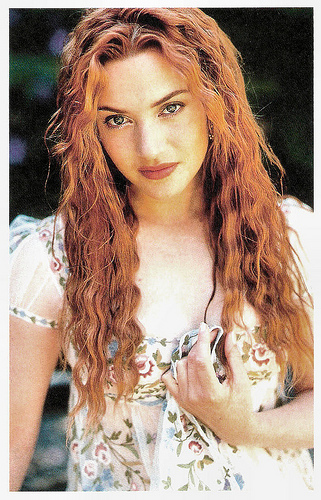
Belgian postcard by P Magazine, no. 37 in the series 'De mooiste vrouwen van de eeuw' (the 100 most beautiful women of the century). Photo: Sante D'Orazio / Outline.
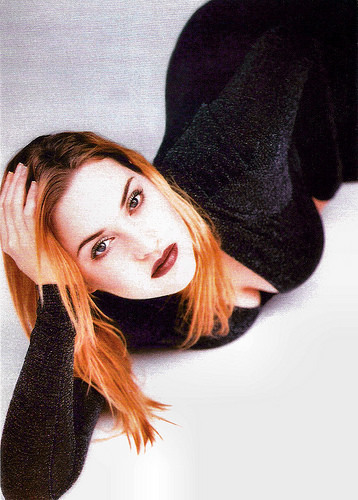
British postcard.
Heavenly Creatures
Kate Elizabeth Winslet was born Reading, England, in 1975. She is the second of four children of stage actors Sally Anne (née Bridges) and Roger John Winslet. Winslet began studying drama at the age of 11. The following year, she appeared in a television commercial for Sugar Puffs cereal, in which she danced opposite the Honey Monster.
Winslet's acting career began on television, with a co-starring role in the BBC children's science fiction serial Dark Season (Colin Cant, 1991). On the set, Winslet met Stephen Tredre, who was working as an assistant director. They would have a four-and-a-half-year relationship, and remained close after their separation in 1995. He died of bone cancer during the opening week of Titanic, causing her to miss the film's Los Angeles premiere to attend his funeral in London.
Her role in Dark Season was followed by appearances in the made-for-TV film Anglo-Saxon Attitudes (Diarmuid Lawrence, 1992), the sitcom Get Back (Graeme Harper, 1992), and an episode of the medical drama Casualty (Tom Cotter, 1993).
She made her film debut in the New Zealand drama film Heavenly Creatures (Peter Jackson, 1994). Winslet auditioned for the part of Juliet Hulme, an obsessive teenager in 1950s New Zealand who assists in the murder of the mother of her best friend, Pauline Parker (played by Melanie Lynskey). Winslet won the role over 175 other girls. The film included Winslet's singing debut, and her a cappella version of Sono Andati, an aria from La Bohème, was featured on the film's soundtrack.
The film opened to strong critical acclaim at the 51st Venice International Film Festival in 1994 and became one of the best-received films of the year. Winslet was awarded an Empire Award and a London Film Critics' Circle Award for British Actress of the Year.
Subsequently she played the second leading role of Marianne Dashwood in the Jane Austen adaptation Sense and Sensibility (Ang Lee, 1995) featuring Emma Thompson, Hugh Grant and Alan Rickman. The film became a financial and critical success, resulting in a worldwide box office total of $135 million and various awards for Winslet. She won both a BAFTA and a Screen Actors' Guild Award, and was nominated for both an Academy Award and a Golden Globe.
In 1996, Winslet starred in Michael Winterbottom's Jude, based on the Victorian novel Jude the Obscure by Thomas Hardy. She played Sue Bridehead, a young woman with suffragette leanings who falls in love with her cousin (Christopher Eccleston).
She then played Ophelia, Hamlet's drowned lover, in Kenneth Branagh's all star-cast film version of William Shakespeare's Hamlet (1996).
In mid-1996, Winslet began filming James Cameron's Titanic (1997), alongside Leonardo DiCaprio. She was cast as the passionate, rosy-cheeked aristocrat Rose DeWitt Bukater, who survives the 1912 sinking of the RMS Titanic. Against expectations, Titanic (1997) became the highest-grossing film in the world at the time and transformed Winslet into a commercial movie star.
Young girls the world over both idolized and identified with Winslet. Despite the enormous success of Titanic, Winslet next starred in two low-budget art-house films, Hideous Kinky (Gillies MacKinnon, 1998), and Holy Smoke! (Jane Campion, 1999).
In 1997, on the set of Hideous Kinky, Winslet met film director Jim Threapleton, whom she married in 1998. They have a daughter, Mia Honey Threapleton (2000). Winslet and Threapleton divorced in 2001.
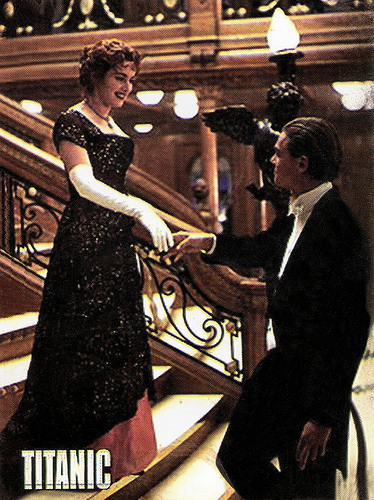
Vintage postcard. Photo: publicity still for Titanic (James Cameron, 1997) with Leonardo DiCaprio.
Eternal Sunshine of the Spotless Mind
Since 2000, Kate Winslet's performances have continued to draw positive comments from film critics. She appeared in the period piece Quills (Philip Kaufman, 2000) with Geoffrey Rush and Joaquin Phoenix, inspired by the life and work of the Marquis de Sade. The actress was the first big name to back the film project, accepting the role of a chambermaid in the asylum and the courier of the Marquis' manuscripts to the underground publishers. Well received by critics, the film garnered numerous accolades for Winslet.
In Enigma (Michael Apted, 2001), she played a young woman who finds herself falling for a brilliant young World War II code breaker (Dougray Scott). She was five months pregnant at the time of the shoot, forcing some tricky camera work.
In the same year she appeared in Iris (Richard Eyre, 2001), portraying novelist Iris Murdoch. Winslet shared her role with Judi Dench, with both actresses portraying Murdoch at different phases of her life. Subsequently, each of them was nominated for an Academy Award the following year, earning Winslet her third nomination.
Also in 2001, she voiced the character Belle in the animation film Christmas Carol: The Movie, based on the Charles Dickens classic novel. For the film, Winslet recorded the song What If, which was a Europe-wide top ten hit.
Winslet began a relationship with director Sam Mendes in 2001, and she married him in 2003 on the island of Anguilla. Their son, Joe Alfie Winslet Mendes, was born in 2003 in New York City. In 2010, Winslet and Mendes announced their separation and divorced in 2011.
In the drama The Life of David Gale (Alan Parker, 2003), she played an ambitious journalist who interviews a death-sentenced professor (Kevin Spacey) in his final weeks before execution.
Next, Winslet appeared with Jim Carrey in Eternal Sunshine of the Spotless Mind (Michel Gondry, 2004). In this neo-surrealistic indie-drama, she played Clementine Kruczynski, a chatty, spontaneous and somewhat neurotic woman, who decides to have all memories of her ex-boyfriend erased from her mind. The film was a critical and financial success and Winslet received rave reviews and her fourth Academy Award-nomination.
Finding Neverland (Marc Forster, 2004), is the story of Scottish writer J.M. Barrie (Johnny Depp) and his platonic relationship with Sylvia Llewelyn Davies (Winslet), whose sons inspired him to pen the classic play Peter Pan, or The Boy Who Wouldn't Grow Up. The film received favourable reviews and became Winslet's highest-grossing film since Titanic.
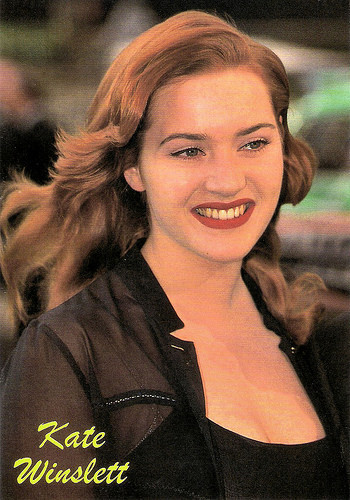
British postcard by Heroes Publishing Ltd, London, no. SFC 3312.
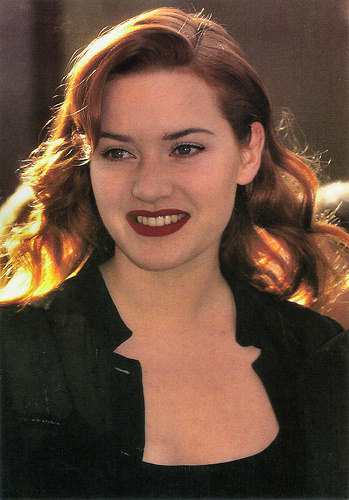
British postcard by Anabas, Essex, no. AP647, 1998.
The Reader
In 2005, Kate Winslet played a satirical version of herself in an episode of the comedy series Extras by Ricky Gervais and Stephen Merchant. While dressed as a nun, she was portrayed giving phone sex tips to the romantically challenged character of Maggie. Her performance in the episode led to her first nomination for an Emmy Award.
In the musical romantic comedy Romance & Cigarettes (John Turturro, 2005), she played the slut Tula, and again Winslet was praised for her performance. In Todd Field's Little Children (2006), she played a bored housewife who has a torrid affair with a married neighbour (Patrick Wilson). Both her performance and the film received rave reviews. Again she was nominated for an Academy Award for Best Actress, and at 31, became the youngest actress to ever garner five Oscar nominations.
Commercial successes were Nancy Meyers' romantic comedy The Holiday (2006), also starring Cameron Diaz, and the CG-animated Flushed Away (2006), in which she voiced Rita, a scavenging sewer rat who helps Roddy (Hugh Jackman) escape from the city of Ratropolis and return to his luxurious Kensington origins.
In 2007, Winslet reunited with Leonardo DiCaprio to film Revolutionary Road (2008), directed by her husband at the time, Sam Mendes. Portraying a couple in a failing marriage in the 1950s, DiCaprio and Winslet watched period videos promoting life in the suburbs to prepare themselves for the film. Winslet was awarded a Golden Globe Award for Best Actress for her performance, her seventh nomination from the Golden Globes.
Then she starred in the film adaptation of Bernhard Schlink's 1995 novel The Reader (Stephen Daldry, 2008) featuring Ralph Fiennes and David Kross in supporting roles. Employing a German accent, Winslet portrayed a former Nazi concentration camp guard who has an affair with a teenager (Kross) who, as an adult, witnesses her war crimes trial. While the film garnered mixed reviews in general. The following year, she earned her sixth Academy Award nomination and went on to win the Best Actress award, the BAFTA Award for Best Actress, a Screen Actors' Guild Award for Outstanding Supporting Actress, and a Golden Globe for Best Supporting Actress.
In 2011, Kate Winslet headlined in the HBO miniseries Mildred Pierce, based on James M. Cain's 1941 novel and directed by Todd Haynes. She portrayed a self-sacrificing mother during the Great Depression who finds herself separated from her husband and falling in love with a new man (Guy Pearce), all the while trying to earn her narcissistic daughter's (Evan Rachel Wood) love and respect. This time, Winslet won an Emmy Award, a Golden Globe Award and a Screen Actors Guild Award.
Roman Polanski's Carnage (2011) premiered at the 68th Venice Film Festival. The black comedy follows two sets of parents who meet up to talk after their children have been in a fight that day at school. Jodie Foster, John C. Reilly and Christoph Waltz co-starred in the film.
In 2012, she was appointed a Commander of the Order of the British Empire (CBE). In Jason Reitman's big screen adaptation of Joyce Maynard's novel Labor Day (2013), she starred with Josh Brolin and Tobey Maguire. Winslet received favourable reviews for her portrayal of Adele, a mentally fragile, repressed single mom of a 13-year-old son who gives shelter to an escaped prisoner during a long summer week-end. For her performance, Winslet earned her tenth Golden Globe nomination.
Next she appeared in the science fiction film Divergent (Neil Burger, 2014), as the bad antagonist Jeanine Matthews. It became one of the biggest commercial successes of her career. This year, Winslet also appeared alongside Matthias Schoenaerts in Alan Rickman's period drama A Little Chaos (2014) about rival landscape gardeners commissioned by Louis XIV to create a fountain at Versailles.
Next she can be seen in the crime-thriller Triple Nine (John Hillcoat, 2015), the sequel in the Divergent series: Insurgent (Robert Schwentke, 2015) and in The Dressmaker (Jocelyn Moorhouse, 2015).
Since 2012, Kate Winslet is married to Ned Rocknroll, a nephew of Richard Branson. The couple has a son, Bear Blaze Winslet. They live in West Sussex.
Kate Winslet sings What If. Official Music Video. Source: Chris Horton Productions (YouTube).
Trailer for The Reader (Stephen Daldry, 2008). Source: Associated Press (YouTube).
Sources: Tom Ryan (Encyclopedia of British Film), Sandra Brennan (AllMovie), Wikipedia, and .

Belgian postcard by P Magazine, no. 37 in the series 'De mooiste vrouwen van de eeuw' (the 100 most beautiful women of the century). Photo: Sante D'Orazio / Outline.

British postcard.
Heavenly Creatures
Kate Elizabeth Winslet was born Reading, England, in 1975. She is the second of four children of stage actors Sally Anne (née Bridges) and Roger John Winslet. Winslet began studying drama at the age of 11. The following year, she appeared in a television commercial for Sugar Puffs cereal, in which she danced opposite the Honey Monster.
Winslet's acting career began on television, with a co-starring role in the BBC children's science fiction serial Dark Season (Colin Cant, 1991). On the set, Winslet met Stephen Tredre, who was working as an assistant director. They would have a four-and-a-half-year relationship, and remained close after their separation in 1995. He died of bone cancer during the opening week of Titanic, causing her to miss the film's Los Angeles premiere to attend his funeral in London.
Her role in Dark Season was followed by appearances in the made-for-TV film Anglo-Saxon Attitudes (Diarmuid Lawrence, 1992), the sitcom Get Back (Graeme Harper, 1992), and an episode of the medical drama Casualty (Tom Cotter, 1993).
She made her film debut in the New Zealand drama film Heavenly Creatures (Peter Jackson, 1994). Winslet auditioned for the part of Juliet Hulme, an obsessive teenager in 1950s New Zealand who assists in the murder of the mother of her best friend, Pauline Parker (played by Melanie Lynskey). Winslet won the role over 175 other girls. The film included Winslet's singing debut, and her a cappella version of Sono Andati, an aria from La Bohème, was featured on the film's soundtrack.
The film opened to strong critical acclaim at the 51st Venice International Film Festival in 1994 and became one of the best-received films of the year. Winslet was awarded an Empire Award and a London Film Critics' Circle Award for British Actress of the Year.
Subsequently she played the second leading role of Marianne Dashwood in the Jane Austen adaptation Sense and Sensibility (Ang Lee, 1995) featuring Emma Thompson, Hugh Grant and Alan Rickman. The film became a financial and critical success, resulting in a worldwide box office total of $135 million and various awards for Winslet. She won both a BAFTA and a Screen Actors' Guild Award, and was nominated for both an Academy Award and a Golden Globe.
In 1996, Winslet starred in Michael Winterbottom's Jude, based on the Victorian novel Jude the Obscure by Thomas Hardy. She played Sue Bridehead, a young woman with suffragette leanings who falls in love with her cousin (Christopher Eccleston).
She then played Ophelia, Hamlet's drowned lover, in Kenneth Branagh's all star-cast film version of William Shakespeare's Hamlet (1996).
In mid-1996, Winslet began filming James Cameron's Titanic (1997), alongside Leonardo DiCaprio. She was cast as the passionate, rosy-cheeked aristocrat Rose DeWitt Bukater, who survives the 1912 sinking of the RMS Titanic. Against expectations, Titanic (1997) became the highest-grossing film in the world at the time and transformed Winslet into a commercial movie star.
Young girls the world over both idolized and identified with Winslet. Despite the enormous success of Titanic, Winslet next starred in two low-budget art-house films, Hideous Kinky (Gillies MacKinnon, 1998), and Holy Smoke! (Jane Campion, 1999).
In 1997, on the set of Hideous Kinky, Winslet met film director Jim Threapleton, whom she married in 1998. They have a daughter, Mia Honey Threapleton (2000). Winslet and Threapleton divorced in 2001.

Vintage postcard. Photo: publicity still for Titanic (James Cameron, 1997) with Leonardo DiCaprio.
Eternal Sunshine of the Spotless Mind
Since 2000, Kate Winslet's performances have continued to draw positive comments from film critics. She appeared in the period piece Quills (Philip Kaufman, 2000) with Geoffrey Rush and Joaquin Phoenix, inspired by the life and work of the Marquis de Sade. The actress was the first big name to back the film project, accepting the role of a chambermaid in the asylum and the courier of the Marquis' manuscripts to the underground publishers. Well received by critics, the film garnered numerous accolades for Winslet.
In Enigma (Michael Apted, 2001), she played a young woman who finds herself falling for a brilliant young World War II code breaker (Dougray Scott). She was five months pregnant at the time of the shoot, forcing some tricky camera work.
In the same year she appeared in Iris (Richard Eyre, 2001), portraying novelist Iris Murdoch. Winslet shared her role with Judi Dench, with both actresses portraying Murdoch at different phases of her life. Subsequently, each of them was nominated for an Academy Award the following year, earning Winslet her third nomination.
Also in 2001, she voiced the character Belle in the animation film Christmas Carol: The Movie, based on the Charles Dickens classic novel. For the film, Winslet recorded the song What If, which was a Europe-wide top ten hit.
Winslet began a relationship with director Sam Mendes in 2001, and she married him in 2003 on the island of Anguilla. Their son, Joe Alfie Winslet Mendes, was born in 2003 in New York City. In 2010, Winslet and Mendes announced their separation and divorced in 2011.
In the drama The Life of David Gale (Alan Parker, 2003), she played an ambitious journalist who interviews a death-sentenced professor (Kevin Spacey) in his final weeks before execution.
Next, Winslet appeared with Jim Carrey in Eternal Sunshine of the Spotless Mind (Michel Gondry, 2004). In this neo-surrealistic indie-drama, she played Clementine Kruczynski, a chatty, spontaneous and somewhat neurotic woman, who decides to have all memories of her ex-boyfriend erased from her mind. The film was a critical and financial success and Winslet received rave reviews and her fourth Academy Award-nomination.
Finding Neverland (Marc Forster, 2004), is the story of Scottish writer J.M. Barrie (Johnny Depp) and his platonic relationship with Sylvia Llewelyn Davies (Winslet), whose sons inspired him to pen the classic play Peter Pan, or The Boy Who Wouldn't Grow Up. The film received favourable reviews and became Winslet's highest-grossing film since Titanic.

British postcard by Heroes Publishing Ltd, London, no. SFC 3312.

British postcard by Anabas, Essex, no. AP647, 1998.
The Reader
In 2005, Kate Winslet played a satirical version of herself in an episode of the comedy series Extras by Ricky Gervais and Stephen Merchant. While dressed as a nun, she was portrayed giving phone sex tips to the romantically challenged character of Maggie. Her performance in the episode led to her first nomination for an Emmy Award.
In the musical romantic comedy Romance & Cigarettes (John Turturro, 2005), she played the slut Tula, and again Winslet was praised for her performance. In Todd Field's Little Children (2006), she played a bored housewife who has a torrid affair with a married neighbour (Patrick Wilson). Both her performance and the film received rave reviews. Again she was nominated for an Academy Award for Best Actress, and at 31, became the youngest actress to ever garner five Oscar nominations.
Commercial successes were Nancy Meyers' romantic comedy The Holiday (2006), also starring Cameron Diaz, and the CG-animated Flushed Away (2006), in which she voiced Rita, a scavenging sewer rat who helps Roddy (Hugh Jackman) escape from the city of Ratropolis and return to his luxurious Kensington origins.
In 2007, Winslet reunited with Leonardo DiCaprio to film Revolutionary Road (2008), directed by her husband at the time, Sam Mendes. Portraying a couple in a failing marriage in the 1950s, DiCaprio and Winslet watched period videos promoting life in the suburbs to prepare themselves for the film. Winslet was awarded a Golden Globe Award for Best Actress for her performance, her seventh nomination from the Golden Globes.
Then she starred in the film adaptation of Bernhard Schlink's 1995 novel The Reader (Stephen Daldry, 2008) featuring Ralph Fiennes and David Kross in supporting roles. Employing a German accent, Winslet portrayed a former Nazi concentration camp guard who has an affair with a teenager (Kross) who, as an adult, witnesses her war crimes trial. While the film garnered mixed reviews in general. The following year, she earned her sixth Academy Award nomination and went on to win the Best Actress award, the BAFTA Award for Best Actress, a Screen Actors' Guild Award for Outstanding Supporting Actress, and a Golden Globe for Best Supporting Actress.
In 2011, Kate Winslet headlined in the HBO miniseries Mildred Pierce, based on James M. Cain's 1941 novel and directed by Todd Haynes. She portrayed a self-sacrificing mother during the Great Depression who finds herself separated from her husband and falling in love with a new man (Guy Pearce), all the while trying to earn her narcissistic daughter's (Evan Rachel Wood) love and respect. This time, Winslet won an Emmy Award, a Golden Globe Award and a Screen Actors Guild Award.
Roman Polanski's Carnage (2011) premiered at the 68th Venice Film Festival. The black comedy follows two sets of parents who meet up to talk after their children have been in a fight that day at school. Jodie Foster, John C. Reilly and Christoph Waltz co-starred in the film.
In 2012, she was appointed a Commander of the Order of the British Empire (CBE). In Jason Reitman's big screen adaptation of Joyce Maynard's novel Labor Day (2013), she starred with Josh Brolin and Tobey Maguire. Winslet received favourable reviews for her portrayal of Adele, a mentally fragile, repressed single mom of a 13-year-old son who gives shelter to an escaped prisoner during a long summer week-end. For her performance, Winslet earned her tenth Golden Globe nomination.
Next she appeared in the science fiction film Divergent (Neil Burger, 2014), as the bad antagonist Jeanine Matthews. It became one of the biggest commercial successes of her career. This year, Winslet also appeared alongside Matthias Schoenaerts in Alan Rickman's period drama A Little Chaos (2014) about rival landscape gardeners commissioned by Louis XIV to create a fountain at Versailles.
Next she can be seen in the crime-thriller Triple Nine (John Hillcoat, 2015), the sequel in the Divergent series: Insurgent (Robert Schwentke, 2015) and in The Dressmaker (Jocelyn Moorhouse, 2015).
Since 2012, Kate Winslet is married to Ned Rocknroll, a nephew of Richard Branson. The couple has a son, Bear Blaze Winslet. They live in West Sussex.
Kate Winslet sings What If. Official Music Video. Source: Chris Horton Productions (YouTube).
Trailer for The Reader (Stephen Daldry, 2008). Source: Associated Press (YouTube).
Sources: Tom Ryan (Encyclopedia of British Film), Sandra Brennan (AllMovie), Wikipedia, and .
Published on January 28, 2015 22:00
January 27, 2015
G. L. Manuel Frères
Today in our series on film star photographers two French brothers, Henri Manuel (1874-1947) and Gaston Manuel (1880-1967). Between the two World wars, their studio G. L. Manuel Frères portrayed 'tout' Paris: Auguste Rodin, Mistinguett, Eric Satie, Josephine Baker, Aristide Bruant, Colette, Jules Renard, Yvonne Printemps et cetera.
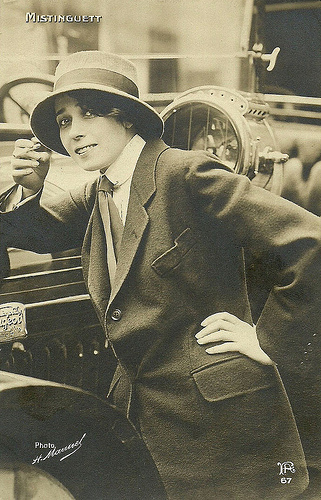
Mistinguett . French postcard by FA, no. 67. Photo: H. Manuel. Collection: Didier Hanson.
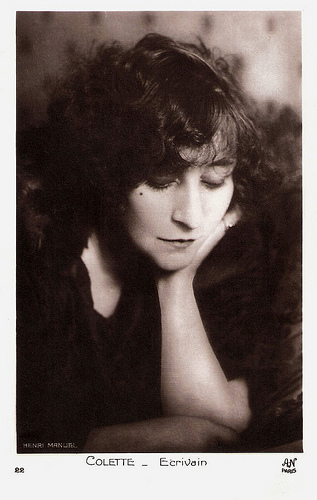
French novelist and performer Sidonie-Gabrielle Colette. French postcard by A.N. Paris, no. 22. Photo: Henri Manuel.
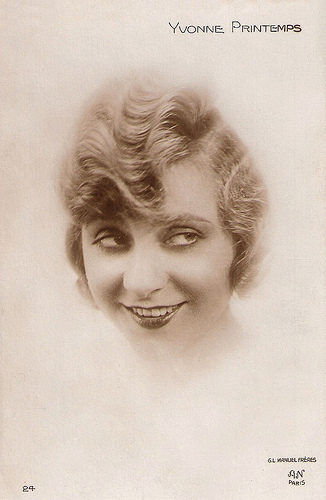
Yvonne Printemps . French postcard by Editions A.N., Paris, no. 24. Photo: G.L. Manuel Frères.
Dancers and actresses from the music halls and casinos
Henri Manuel was born in Paris in 1874. His brother Gaston was six years younger and born in 1880, also in the French capital.
In 1900, the two brothers opened their portrait studio in Paris, G. L. Manuel Frères (Gaston Lucien Manuel Brothers)
They specialised in portrait photography. Henri Manuel quickly became renowned as a photographer of people from the worlds of politics, art and sports, as well as a photographer of art and architecture.
Notable authors they portrayed include Tristan Bernard, Jean Cocteau, Colette, Sacha Guitry, Paul Morand, and Marcel Pagnol. Other figures include Louis Barthou, prime minister of France in 1913; Georges Clemenceau, statesman and twice prime minister; Marshal of France Ferdinand Foch, allied supreme commander in World War I; Vicomtesse Marie-Laure de Noailles; and Raymond Poincar president of France from 1913 to 1920.
Henri also produced postcards of dancers and actresses from the music halls and casinos and his name is sometimes appended to Reutlinger postcards, indicating there was a collaboration of some form.
Soon his portraits were used by news agencies, and in 1910 Manuel's studio began providing a commercial service to news agencies for photographs known as 'l’Agence universelle de reportage Henri Manuel'.
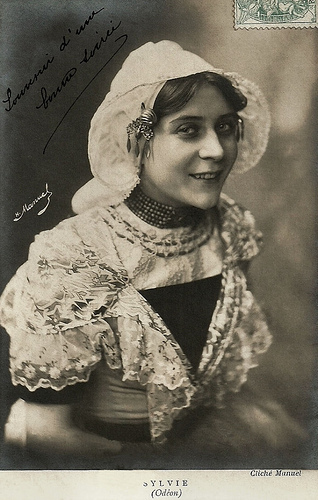
Sylvie . French postcard. Photo: Manuel. The caption goes: 'Souvenir d'un bonne soirée' (Memory of a nice night). On the verso lines from the play Vieil Heidelberg.
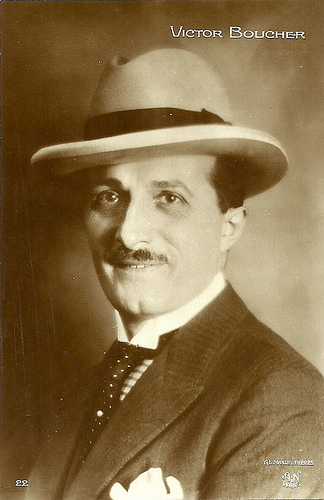
Victor Boucher . French postcard by A.N., Paris, no. 22. Photo G.L. Manuel Frères.
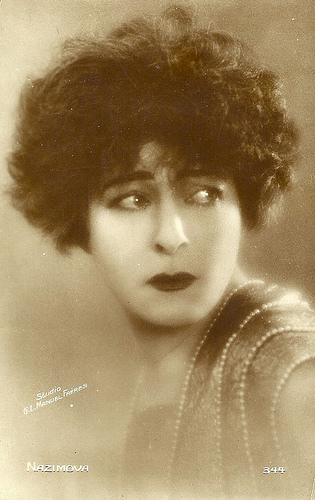
Nazimova. French postcard, no. 344. Photo: Studio G.L. Manuel Frères. Collection: Didier Hanson.
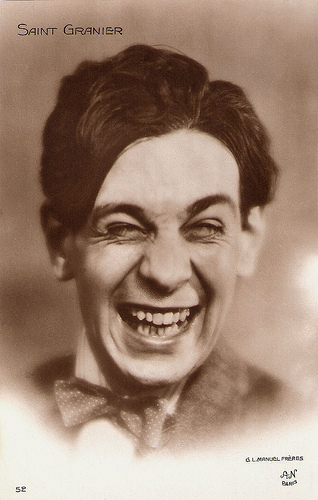
Saint-Granier . French postcard by A.N., Paris, no. 52. Photo: G.L. Manuel Frères.
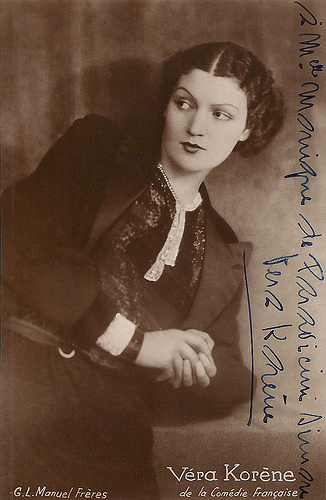
Vera Korène . French postcard. Photo: G.L. Manuel Frères. Collection: Didier Hanson.
The naked reality of imprisonment
From 1914 till 1944, Henri Manuel served as the official photographer of the French government. Manuel also produced numerous photo reports during official ceremonies.
The studio became the largest photographic studio in Paris and a leading centre where young aspiring photographers such as Paris-based American photographer Thérèse Bonney might go to work.
In 1925, the brothers moved their business to 27 rue du Faubourg in Montmartre, where they expanded their business into fashion photography for the likes of Chanel, Patou, Poiret and Lanvin.
Manuel worked for thirty fashion magazines and especially for La Femme de France (1922-1935), Les Grandes Modes de Paris (1906-1931), Les Modes de la femme de France (1922-1935), and Le Petit Écho de la mode (1928-1936).
Between 1928 and 1932, Henri Manuel was also the remarkable witness of the Clairvaux prison. He took 132 shots of Clairvaux which give a striking image of the French prison system in the first half of the twentieth century. He photographed the naked reality of imprisonment, labour, discipline for the hundreds of prisoners but also the environment of their guards.
By 1941 the studio had produced over a million images, spread between fashion photographs, news agency photographs, personal portraits and other images.
The studio was sequestered during the Second World War, and the majority of the photographic plates have been destroyed after 1945.
Some 600 plates survived and were purchased by the state in 1988. They are held at the photo archive of the Médiathèque de l’architecture et du patrimoine.
Henri Manuel was married with Rachel Camille Meyer. He died in 1947 in Neuilly-sur-Seine. Gaston died in 1967.
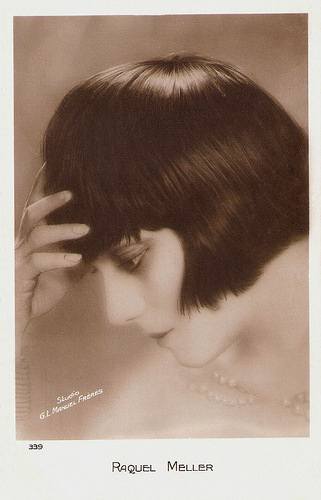
Raquel Meller . French postcard by Cinémagazine Edition, no. 339. Photo: G.L. Manuel Frères.
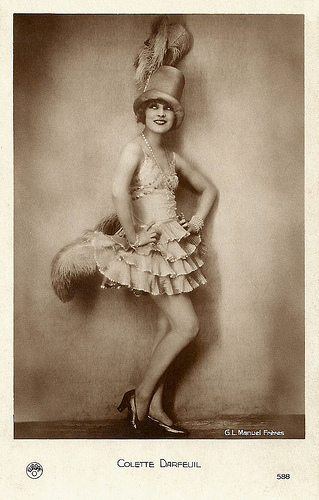
Colette Darfeuil . French postcard by Europe, no. 588. Photo: G.L. Manuel Frères.
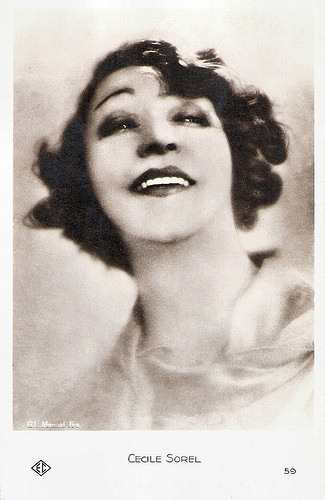
Cécile Sorel . French postcard by E.C. (Editions Chantal), Paris, no. 59. Photo: G.L. Manuel Frères, Paris.
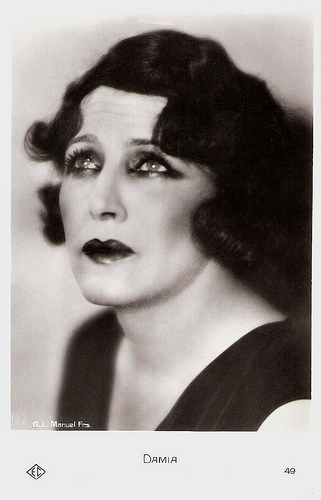
Damia . French postcard by Editions Chantal (EC), no. 49. Photo: G.L. Manuel Frères.
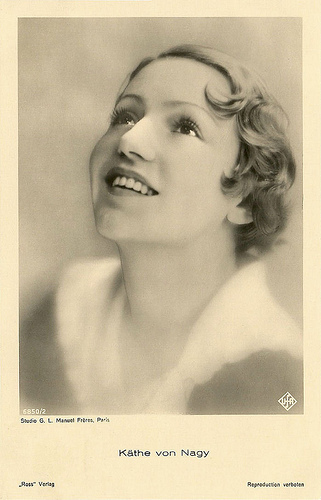
Käthe von Nagy . German postcard by Ross Verlag, no. 6850/2, 1931-1932. Photo: G.L. Manuel Frères, Paris / Ufa. Collection: Didier Hanson.
Check out our other posts on film star photographers. See the links at right under the caption 'The Photographers'.
Sources: Médiathèque de l’architecture et du patrimoine (French), L'Est Eclair (French), John Toohey (Luminous Lint), Wikipedia (English and French).

Mistinguett . French postcard by FA, no. 67. Photo: H. Manuel. Collection: Didier Hanson.

French novelist and performer Sidonie-Gabrielle Colette. French postcard by A.N. Paris, no. 22. Photo: Henri Manuel.

Yvonne Printemps . French postcard by Editions A.N., Paris, no. 24. Photo: G.L. Manuel Frères.
Dancers and actresses from the music halls and casinos
Henri Manuel was born in Paris in 1874. His brother Gaston was six years younger and born in 1880, also in the French capital.
In 1900, the two brothers opened their portrait studio in Paris, G. L. Manuel Frères (Gaston Lucien Manuel Brothers)
They specialised in portrait photography. Henri Manuel quickly became renowned as a photographer of people from the worlds of politics, art and sports, as well as a photographer of art and architecture.
Notable authors they portrayed include Tristan Bernard, Jean Cocteau, Colette, Sacha Guitry, Paul Morand, and Marcel Pagnol. Other figures include Louis Barthou, prime minister of France in 1913; Georges Clemenceau, statesman and twice prime minister; Marshal of France Ferdinand Foch, allied supreme commander in World War I; Vicomtesse Marie-Laure de Noailles; and Raymond Poincar president of France from 1913 to 1920.
Henri also produced postcards of dancers and actresses from the music halls and casinos and his name is sometimes appended to Reutlinger postcards, indicating there was a collaboration of some form.
Soon his portraits were used by news agencies, and in 1910 Manuel's studio began providing a commercial service to news agencies for photographs known as 'l’Agence universelle de reportage Henri Manuel'.

Sylvie . French postcard. Photo: Manuel. The caption goes: 'Souvenir d'un bonne soirée' (Memory of a nice night). On the verso lines from the play Vieil Heidelberg.

Victor Boucher . French postcard by A.N., Paris, no. 22. Photo G.L. Manuel Frères.

Nazimova. French postcard, no. 344. Photo: Studio G.L. Manuel Frères. Collection: Didier Hanson.

Saint-Granier . French postcard by A.N., Paris, no. 52. Photo: G.L. Manuel Frères.

Vera Korène . French postcard. Photo: G.L. Manuel Frères. Collection: Didier Hanson.
The naked reality of imprisonment
From 1914 till 1944, Henri Manuel served as the official photographer of the French government. Manuel also produced numerous photo reports during official ceremonies.
The studio became the largest photographic studio in Paris and a leading centre where young aspiring photographers such as Paris-based American photographer Thérèse Bonney might go to work.
In 1925, the brothers moved their business to 27 rue du Faubourg in Montmartre, where they expanded their business into fashion photography for the likes of Chanel, Patou, Poiret and Lanvin.
Manuel worked for thirty fashion magazines and especially for La Femme de France (1922-1935), Les Grandes Modes de Paris (1906-1931), Les Modes de la femme de France (1922-1935), and Le Petit Écho de la mode (1928-1936).
Between 1928 and 1932, Henri Manuel was also the remarkable witness of the Clairvaux prison. He took 132 shots of Clairvaux which give a striking image of the French prison system in the first half of the twentieth century. He photographed the naked reality of imprisonment, labour, discipline for the hundreds of prisoners but also the environment of their guards.
By 1941 the studio had produced over a million images, spread between fashion photographs, news agency photographs, personal portraits and other images.
The studio was sequestered during the Second World War, and the majority of the photographic plates have been destroyed after 1945.
Some 600 plates survived and were purchased by the state in 1988. They are held at the photo archive of the Médiathèque de l’architecture et du patrimoine.
Henri Manuel was married with Rachel Camille Meyer. He died in 1947 in Neuilly-sur-Seine. Gaston died in 1967.

Raquel Meller . French postcard by Cinémagazine Edition, no. 339. Photo: G.L. Manuel Frères.

Colette Darfeuil . French postcard by Europe, no. 588. Photo: G.L. Manuel Frères.

Cécile Sorel . French postcard by E.C. (Editions Chantal), Paris, no. 59. Photo: G.L. Manuel Frères, Paris.

Damia . French postcard by Editions Chantal (EC), no. 49. Photo: G.L. Manuel Frères.

Käthe von Nagy . German postcard by Ross Verlag, no. 6850/2, 1931-1932. Photo: G.L. Manuel Frères, Paris / Ufa. Collection: Didier Hanson.
Check out our other posts on film star photographers. See the links at right under the caption 'The Photographers'.
Sources: Médiathèque de l’architecture et du patrimoine (French), L'Est Eclair (French), John Toohey (Luminous Lint), Wikipedia (English and French).
Published on January 27, 2015 22:00
January 26, 2015
Margit Nünke
Gorgeous German actress Margit Nünke (1930) started as a fashion model and beauty queen. Between 1957 and 1965 she played in nine films.
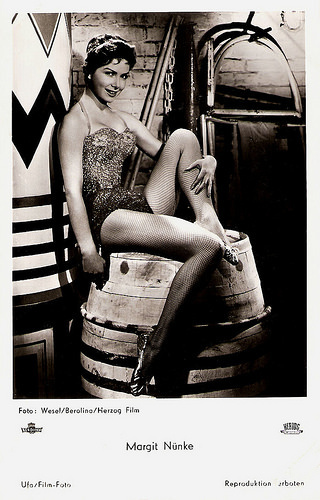
German postcard by Ufa, Berlin-Tempelhof, no. FK 3615. Photo: Wesel / Berolina / Herzog Film. Publicity still for Das haut hin/The skin-out (Géza von Cziffra, 1957).
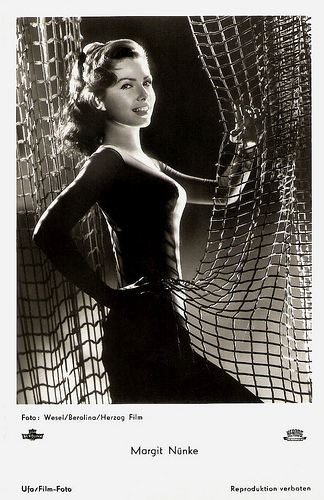
German postcard by Ufa, Berlin-Tempelhof, no. FK 3614. Photo: Wesel / Berolina / Herzog Film.
Miss Germany
Margit Nünke was born in Stettin, Germany (now Szczecin, Poland) in 1930. She became Miss Germany in 1955 after previously being Miss North Rhine-Westphalia.
The following year, 1956, she won the Miss Europe pageant in Stockholm before 12 other candidates and in front of 5,000 spectators. Finally, she reached the 4th place at the Miss Universe contest in Long Beach, USA, in 1958 (in 1955, according to Wikipedia ).
From 1957 on she appeared in feature films and TV movies. In Italy, she acted opposite Rik Battaglia and Sylva Koscina in I fidanzati della morte/The betrothed of death (Romolo Marcellini, 1957).
In the German musical comedy Das haut hin/The skin-out (Géza von Cziffra, 1957), she appeared opposite the popular Peter Alexander . On TV she starred in the crime mini-series Gesucht wird Mörder X/Wanted murderer X (Volker von Collande, 1959).
In the Austrian film Geliebte Bestie/Arena of Fear (Arthur Maria Rabenalt, 1959), she put her dancing skills to the test. The film plays in the circus milieu, and Nünke played Beatrix, a dancer who plans to act in an animal cage and plays up to circus tiger trainer Gerhard Riedmann so that she can join his act. Nünke also seduces the sharpshooter ( Willy Birgel ), who becomes jealous and drugs the tigers, then kills himself when he's found out.
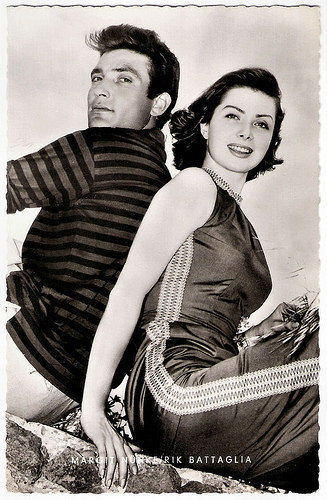
German postcard by Kunst und Bild, Berlin-Charlottenburg, no. T 850. Photo: Deutsche Cosmopol / Ringpress / Vogelmann. Publicity still for I fidanzati della morte/The betrothed of death (Romolo Marcellini, 1957) with Rik Battaglia .
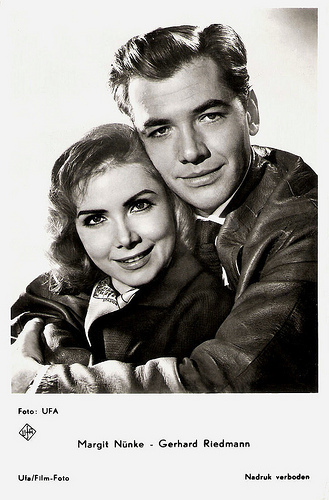
Dutch postcard by DRC Holland, no. 1223. Photo: Ufa. Publicity still for Geliebte Bestie/Arena of Fear (Arthur Maria Rabenalt, 1959) with Gerhard Riedmann.
Lighter-than-light entertainment
In the next decade, Margit Nünke continued to appear in German lighter-than-light entertainment films with such film partners as Walter Giller and Toni Sailer .
Titles include the Conny Froboess comedy Meine Nichte tut das nicht/My Niece Doesn't Do That (Franz Josef Gottlieb, 1960), and Liebesgrüße aus Tirol/With Love from Tyrol (Franz Antel, 1964) with Peter Weck and Gitte Hænning .
For TV, she worked a few times with comedian Willy Millowitsch, such as in Der kühne Schwimmer/The bold swimmer (Willy Millowitsch, 1960).
As a singer, she recorded several singles, including the duet Jede Woche, die hat 7 Tage (Every week has 7 days) with Peter Garden . They married. Together, they performed in his TV-series Garden-Party (1969-1970).
After an interval of more than a decennium, she appeared in the TV series Eine Klasse für sich - Geschichten aus einem Internat/A class apart (Frank Strecker, 1984) and in an episode of the comedy series Heiße Wickel - kalte Güsse/ Hot Wraps - cold treatments (Franz Josef Gottlieb, 1984). These were her last screen appearances.
Margit Nünke lives in Munich, Germany.
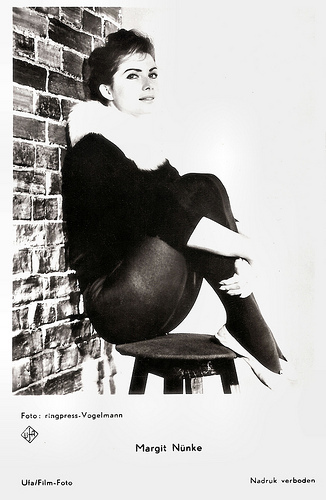
German postcard by Ufa, Berlin-Tempelhof, no. 4332. Photo: Ringpress / Vogelmann.
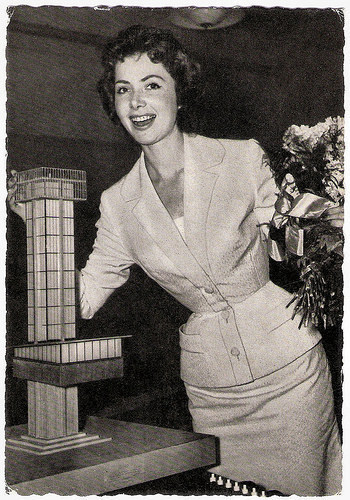
German postcard by WS-Druck, Wanne-Eickel, no. 189. Photo: dpa.
Sources: Hal Erickson (AllMovie), Wikipedia (German and English) and .

German postcard by Ufa, Berlin-Tempelhof, no. FK 3615. Photo: Wesel / Berolina / Herzog Film. Publicity still for Das haut hin/The skin-out (Géza von Cziffra, 1957).

German postcard by Ufa, Berlin-Tempelhof, no. FK 3614. Photo: Wesel / Berolina / Herzog Film.
Miss Germany
Margit Nünke was born in Stettin, Germany (now Szczecin, Poland) in 1930. She became Miss Germany in 1955 after previously being Miss North Rhine-Westphalia.
The following year, 1956, she won the Miss Europe pageant in Stockholm before 12 other candidates and in front of 5,000 spectators. Finally, she reached the 4th place at the Miss Universe contest in Long Beach, USA, in 1958 (in 1955, according to Wikipedia ).
From 1957 on she appeared in feature films and TV movies. In Italy, she acted opposite Rik Battaglia and Sylva Koscina in I fidanzati della morte/The betrothed of death (Romolo Marcellini, 1957).
In the German musical comedy Das haut hin/The skin-out (Géza von Cziffra, 1957), she appeared opposite the popular Peter Alexander . On TV she starred in the crime mini-series Gesucht wird Mörder X/Wanted murderer X (Volker von Collande, 1959).
In the Austrian film Geliebte Bestie/Arena of Fear (Arthur Maria Rabenalt, 1959), she put her dancing skills to the test. The film plays in the circus milieu, and Nünke played Beatrix, a dancer who plans to act in an animal cage and plays up to circus tiger trainer Gerhard Riedmann so that she can join his act. Nünke also seduces the sharpshooter ( Willy Birgel ), who becomes jealous and drugs the tigers, then kills himself when he's found out.

German postcard by Kunst und Bild, Berlin-Charlottenburg, no. T 850. Photo: Deutsche Cosmopol / Ringpress / Vogelmann. Publicity still for I fidanzati della morte/The betrothed of death (Romolo Marcellini, 1957) with Rik Battaglia .

Dutch postcard by DRC Holland, no. 1223. Photo: Ufa. Publicity still for Geliebte Bestie/Arena of Fear (Arthur Maria Rabenalt, 1959) with Gerhard Riedmann.
Lighter-than-light entertainment
In the next decade, Margit Nünke continued to appear in German lighter-than-light entertainment films with such film partners as Walter Giller and Toni Sailer .
Titles include the Conny Froboess comedy Meine Nichte tut das nicht/My Niece Doesn't Do That (Franz Josef Gottlieb, 1960), and Liebesgrüße aus Tirol/With Love from Tyrol (Franz Antel, 1964) with Peter Weck and Gitte Hænning .
For TV, she worked a few times with comedian Willy Millowitsch, such as in Der kühne Schwimmer/The bold swimmer (Willy Millowitsch, 1960).
As a singer, she recorded several singles, including the duet Jede Woche, die hat 7 Tage (Every week has 7 days) with Peter Garden . They married. Together, they performed in his TV-series Garden-Party (1969-1970).
After an interval of more than a decennium, she appeared in the TV series Eine Klasse für sich - Geschichten aus einem Internat/A class apart (Frank Strecker, 1984) and in an episode of the comedy series Heiße Wickel - kalte Güsse/ Hot Wraps - cold treatments (Franz Josef Gottlieb, 1984). These were her last screen appearances.
Margit Nünke lives in Munich, Germany.

German postcard by Ufa, Berlin-Tempelhof, no. 4332. Photo: Ringpress / Vogelmann.

German postcard by WS-Druck, Wanne-Eickel, no. 189. Photo: dpa.
Sources: Hal Erickson (AllMovie), Wikipedia (German and English) and .
Published on January 26, 2015 22:00
Paul van Yperen's Blog
- Paul van Yperen's profile
- 13 followers
Paul van Yperen isn't a Goodreads Author
(yet),
but they
do have a blog,
so here are some recent posts imported from
their feed.



